Arctic Cat 6000 2021, 8000 2021 Service Manual
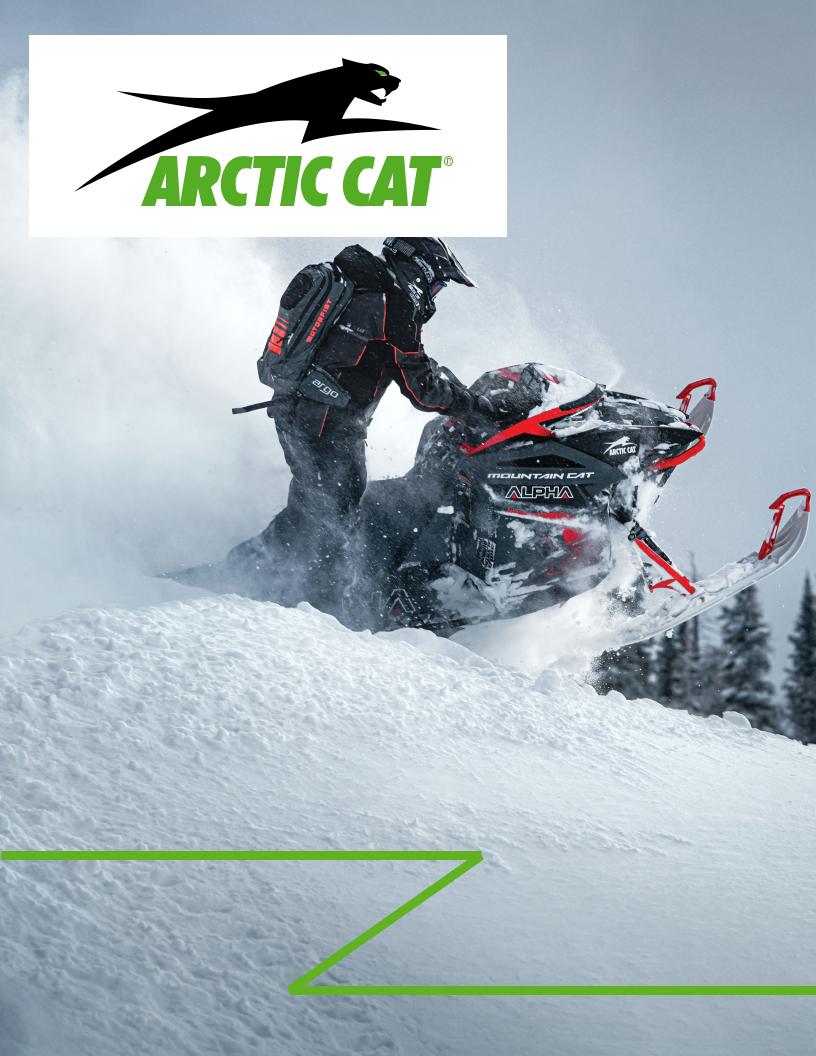
2021
6000/8000
SERVICE MANUAL
P/N-2263-103
Table of Contents
General Information/Foreword ............................................... |
2 |
Snowmobile Identification ........................................................ |
2 |
Recommended Gasoline and Oil ............................................. |
2 |
Engine Break-In ....................................................................... |
3 |
Drive Belt Break-In................................................................... |
3 |
Genuine Parts .......................................................................... |
3 |
Varying Altitude Operation........................................................ |
3 |
Preparation for Storage............................................................ |
4 |
Preparation after Storage......................................................... |
5 |
After Break-In Checkup/Checklist ............................................ |
6 |
Engine Specifications............................................................... |
6 |
Crankshaft Runout/Repair Specifications ................................ |
7 |
Arctic Power Valve (APV) System Specifications .................... |
7 |
Electrical Specifications ........................................................... |
8 |
Drive System Specifications..................................................... |
8 |
Drive Clutch/Driven Clutch-Related Specifications .................. |
8 |
Drive System Components ...................................................... |
8 |
Chain Case Performance Calibrations..................................... |
9 |
Track Specifications ............................................................... |
11 |
Torque Conversions ............................................................... |
11 |
Torque Specifications............................................................. |
11 |
Steering and Body................................................................. |
13 |
Steering Post (Laydown)........................................................ |
13 |
Steering Post (Vertical) .......................................................... |
15 |
Ski (ZR/Riot)........................................................................... |
18 |
Ski (Norseman X)................................................................... |
18 |
Ski (Riot X/Alpha One)........................................................... |
19 |
Ski Wear Bar .......................................................................... |
20 |
Spindle (ZR/Riot).................................................................... |
20 |
Spindle (Norseman X)............................................................ |
20 |
Spindle (Riot X/Alpha One).................................................... |
21 |
Steering Tie Rod .................................................................... |
21 |
Ski Alignment ......................................................................... |
24 |
A-Arms (ZR/Riot).................................................................... |
25 |
A-Arms (Norseman X)............................................................ |
26 |
A-Arms (Riot X/Alpha One).................................................... |
28 |
Ski Shock Absorber................................................................ |
29 |
Sway Bar (ZR/Riot/Norseman X) ........................................... |
30 |
Front Bumper ......................................................................... |
30 |
Seat Assembly (ZR/Riot)........................................................ |
30 |
Seat Assembly (Norseman X) ................................................ |
31 |
Seat Assembly (Alpha One)................................................... |
31 |
Taillight/Brake Light Assembly (ZR/Riot/Alpha One) ............. |
32 |
Taillight/Brake Light Assembly (Norseman X) ........................ |
32 |
Rear Bumper/Snowflap.......................................................... |
32 |
Windshield/Console/ Headlight .............................................. |
33 |
Headlight Bulb — Non-LED ................................................... |
34 |
Adjusting Headlight Aim ........................................................ |
34 |
Engine..................................................................................... |
35 |
Engine Removing/Installing.................................................... |
35 |
Assembly Schematic.............................................................. |
41 |
Engine Servicing (6000)......................................................... |
43 |
Engine Servicing (8000 Early Build)...................................... |
56 |
Engine Servicing (8000)......................................................... |
68 |
Troubleshooting Engine ......................................................... |
81 |
Engine-Related Items................................................................ |
83 |
Water Pump........................................................................... |
83 |
Pressure Testing Engine........................................................ |
85 |
Liquid Cooling System........................................................... |
85 |
Cooling System Schematic.................................................... |
86 |
Recoil Starter......................................................................... |
86 |
Arctic Power Valve (APV) System ......................................... |
88 |
Troubleshooting Arctic Power Valve (APV) System............... |
94 |
Exhaust Controlled Timing (ECT) System ............................. |
94 |
Fuel Systems .......................................................................... |
95 |
EFI System ............................................................................ |
95 |
Individual Components .......................................................... |
95 |
Self-Diagnostic System/Codes .............................................. |
97 |
Fuel Pressure Regulator........................................................ |
98 |
Throttle Body Assembly......................................................... |
98 |
Throttle Cable ........................................................................ |
98 |
Fuel Pump ............................................................................. |
99 |
Troubleshooting Fuel Systems ............................................ |
101 |
Electric Oil Pump ................................................................. |
101 |
Gas Tank.............................................................................. |
102 |
Electrical Systems ............................................................... |
103 |
Ignition System .................................................................... |
103 |
Throttle Position Sensor ...................................................... |
103 |
Electrical Resistance Tests.................................................. |
104 |
Testing Electric Oil Pump..................................................... |
105 |
Testing Voltage Regulator.................................................... |
105 |
Testing Oil Level Sensor...................................................... |
106 |
Testing Fuel Gauge Sender................................................. |
106 |
Emergency Stop Switch ...................................................... |
106 |
Starter Relay Solenoid......................................................... |
106 |
Fuse..................................................................................... |
107 |
Ignition Switch ..................................................................... |
107 |
Starter Motor........................................................................ |
107 |
Troubleshooting Electric Start............................................... |
110 |
Brake Light Switch................................................................ |
111 |
Testing Headlight Dimmer Switch......................................... |
111 |
Testing Handlebar Warmer Elements .................................. |
111 |
Testing Thumb Warmer Element .......................................... |
111 |
Testing Handlebar Warmer/Thumb Warmer Switch.............. |
112 |
Testing Tether ....................................................................... |
112 |
Testing Speedometer Sensor ............................................... |
112 |
Testing Shift Switch .............................................................. |
112 |
Drivetrain/Track/Brake Systems ......................................... |
113 |
Drive Belt .............................................................................. |
113 |
Drive Clutch .......................................................................... |
113 |
Driven Clutch ........................................................................ |
115 |
Drive Clutch/Driven Clutch ................................................... |
117 |
Drivetrain .............................................................................. |
118 |
Drive Sprockets (ZR/Riot/Norseman X)............................... |
124 |
Drive Sprockets (Riot X/Alpha One) ................................... |
126 |
Track Tension ...................................................................... |
127 |
Track Alignment ................................................................... |
128 |
Brake System ...................................................................... |
129 |
Brake Lever/Master Cylinder Assembly............................... |
133 |
Troubleshooting Hydraulic Brake System............................ |
134 |
Troubleshooting Track ......................................................... |
135 |
Troubleshooting Drive Clutch/Driven Clutch........................ |
136 |
Suspension........................................................................... |
137 |
Suspension Setup Basics.................................................... |
137 |
Chassis and Skid Frame Mounting Locations ..................... |
143 |
Servicing Suspension .......................................................... |
146 |
FOX Air Shocks ................................................................... |
162 |
Servicing IFP Shocks........................................................... |
163 |
1
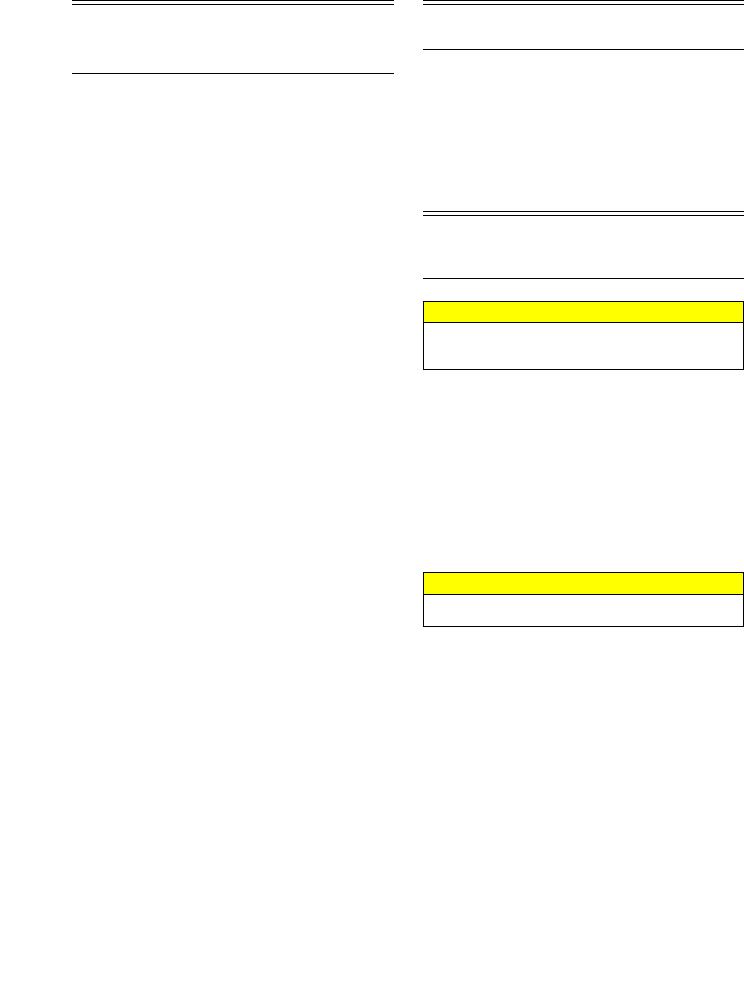
General
Information/Foreword
NOTE: General specifications for each 2021 Arctic
Cat Snowmobile can be accessed from the Arctic Cat Cat Tracker Dealer Communication System.
NOTE: Some illustrations and photographs used in this section are used for clarity purposes only and are not designed to depict actual conditions.
This Service Manual contains service and maintenance information for 2021 Arctic Cat ZR, Riot, Alpha One and Norseman X snowmobile models. The manual is designed to aid service personnel in service-oriented applications.
This manual is divided into sections that cover specific snowmobile components or systems and, in addition to the standard service procedures, include assembling, disassembling, and inspecting instructions. When using this manual as a guide, the technician should use discretion as to how much disassembly is needed to correct any given condition.
The service technician should become familiar with the operation and construction of the components or systems by carefully studying the complete manual. This will assist the service technician in becoming more aware of and efficient with servicing procedures. Such efficiency not only helps build consumer confidence but also saves time and labor.
All Arctic Cat publications and snowmobile decals dis-
play the words Warning, Caution, and Note to emphasize important information. The symbol ! WARNING
identifies personal safety-related information. Be sure to
follow the directive because it deals with the possibility of severe personal injury or even death. A CAUTION
identifies unsafe practices which may result in snowmo- bile-related damage. Follow the directive because it deals with the possibility of damaging part or parts of the snowmobile. The symbol NOTE: identifies supplementary information worthy of particular attention.
At the time of publication, all information, photographs, and illustrations were technically correct. Some photographs and illustrations used in this manual are used for clarity purposes only and are not designed to depict actual conditions. Because Arctic Cat Inc. constantly refines and improves its products, no retroactive obligation is incurred.
All materials and specifications are subject to change without notice.
Product Service and Warranty Department Arctic Cat Inc.
Snowmobile Identification
The Arctic Cat Snowmobile has two important identification numbers. The Vehicle Identification Number (VIN) is stamped into the tunnel near the right-side footrest. The decal also displays pertinent production information. The Engine Serial Number (ESN) is stamped into the crankcase of the engine.
These numbers are required to complete warranty claims properly. No warranty will be allowed by Arctic Cat if the engine serial number or VIN is removed or mutilated in any way.
Recommended Gasoline
and Oil
CAUTION
Do not use white gas or gasoline containing methanol. Only Arctic Cat-approved gasoline additives should be used.
RECOMMENDED GASOLINE
The recommended gasoline to use is 91 octane (minimum).
NOTE: If a situation arises in which 91 octane gasoline is not available, 87 octane gasoline can be substituted; however, do not prolong the usage of 87 octane gasoline as it will cause poor engine performance.
In many areas, oxygenates are added to the gasoline. Oxygenated gasolines containing up to 10% ethanol are acceptable gasolines.
RECOMMENDED OIL
CAUTION
Any oil used in place of the recommended oil may cause serious damage.
The recommended oil to use in the oil-injection system is Arctic Cat C-TEC2 Synthetic 2-Cycle Oil (p/n 8639-118 — quart), (p/n 7639-840 — gal.), or (p/n 6639-521 — 2.5 gal.) This oil is specially formulated to be used and meets all of the lubrication requirements of the Arctic Cat C-TEC2 snowmobile engine.
2
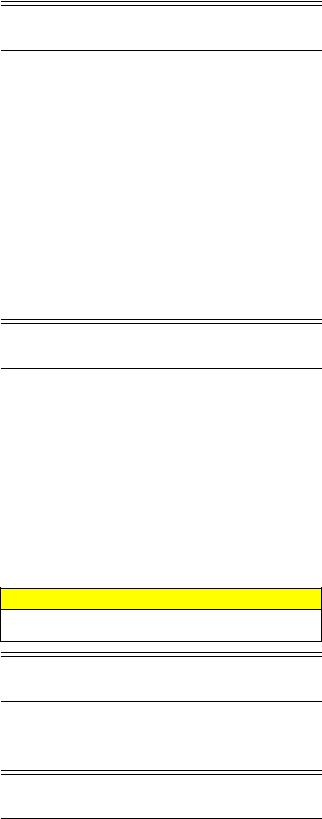
Engine Break-In
The Arctic Cat engine (when new) requires a short break-in period before the engine is subjected to heavy load conditions.
The break-in period occurs in two stages. Stage One occurs during the first 18 minutes of a new engine's run time where the ECM will provide additional fuel and oil to the engine. Stage Two occurs after the completion of Stage One. However, Stage Two still provides additional fuel and oil to the engine for the remainder of 6 hours. This additional fuel and oil is less than the amount added during Stage One.
Premixing fuel and oil during the break in period is not required. Due to the oil delivery control strategy of the electronic oil pump, the oil pump will automatically compensate and deliver a richer fuel-oil ratio during the engine break-in period.
Drive Belt Break-In
Drive belts require a break-in period of 25 miles (40 km). Drive the snowmobile for 25 miles (40 km) at 3/4 throttle or less. By revving the engine up and down (but not exceeding 60 mph/97 km/h), the exposed cord on the side of a new belt will be worn down. This will allow the drive belt to gain its optimum flexibility and will extend drive belt life.
NOTE: Before starting the snowmobile in extremely cold temperatures, the drive belt should be removed and warmed up to room temperature. Once the drive belt is at room temperature, install the drive belt (see Drive Belt sub-section in the Drivetrain/Track/Brake Systems section of this manual).
CAUTION
Running the engine with the drive belt removed could result in serious engine damage and drive clutch failure.
Genuine Parts
When replacement of parts is necessary, use only genuine Arctic Cat parts. They are precision-made to ensure high quality and correct fit.
Varying Altitude Operation
Operating a snowmobile at varying altitudes requires recalibration of drive system components. Consult the appropriate specification sheet on Cat Tracker Online.
Following are basic altitude theories for clutching, engine, suspension, and track.
CLUTCHING
On a normally-aspirated engine as altitude changes, engine horsepower changes with it. As you go up in altitude, the engine loses horsepower. Because of this, the continuously variable transmission (CVT) system needs to be calibrated to compensate for the horsepower loss.
At altitudes above 5000 ft (1524 m), the engine loses peak horsepower but will also lose horsepower at engagement speed. For this reason, calibrating the drive system is usually needed in order to attain acceptable performance. Changing drive clutch engagement speed can be done several ways. Some of the methods will affect other characteristics of CVT operation, so you must be careful what you change. Drive clutch springs are the most common way to increase engagement speed; however, by simply changing the cam arms to a lighter weight from the heavier sea level cam arm, you will gain some engagement speed.
The driven clutch will also play a part in CVT tuning for high altitude operation. A steeper helix (torque bracket) angle in the driven clutch will mean a quicker up-shift. A shallower angle will mean a slower up-shift. If the up-shift is too quick, due to a very steep helix, RPM will be pulled down under the peak operating RPM of the engine (where the horsepower is) and performance will suffer. The engine may even bog.
ENGINE
A normally aspirated engine will generate more horsepower at sea level than it does at higher altitudes. The reason is that the higher you go, less oxygen is available for the engine to use during its combustion process. Less oxygen means it needs less fuel to obtain the correct air/fuel ratio to operate properly. This is why the fuel ratio has to be recalibrated. High altitude engines operate as though they have a lower compression ratio. This, along with less oxygen and less fuel, means that the engine generates less horsepower. All of these characteristics will become more evident the higher the altitude.
SUSPENSION
The different riding styles of the individual operator, the varying snow conditions, and the type of terrain are all factors that affect the suspension at high altitude. Trail riding versus powder snow riding versus combination riding will all require different suspension settings.
The rear suspension has a number of spring settings that produce different riding characteristics.
The front arm spring and shock will also affect the ride and handling when either on a trail or in powder snow. A strong spring setting on this shock will cause the snowmobile to tend to “dig” more when riding in the powder snow rather than climbing up on top of the snow. But, it will work more effectively when riding on a trail. A softer spring setting will allow the front of the rear suspension to collapse much quicker and change the angle of the track to the snow. A more gradual angle will tend to raise the snowmobile up on the snow rather than digging into it.
Many possible variables and adjustments to the rear suspension exist depending on snow conditions, riding style, and type of terrain. These adjustments can be made to individualize the snowmobile to the riding style of the operator.
3
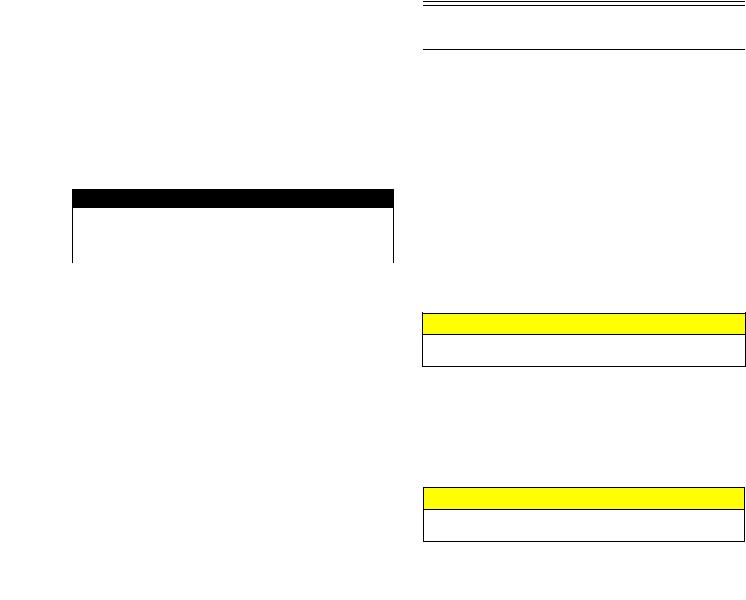
As snow cover and riding conditions change, several different adjustments can be made to change the ride and handling characteristics for operator preference. Located on the front suspension arm are limiter straps. They limit the amount of “fallout” the front arm can have. These straps may be adjusted in or out due to conditions and riding style. The more the straps are brought up, the more steering power the operator has due to the amount of ski pressure.
Another adjustment that can be made on the rear suspension is the front arm shock spring tension. As trail conditions change, the spring preload may be used to decrease the chance of the front end “bottoming out.” With a stiffer spring preload, the ride of the snowmobile will improve on the trail but will affect the performance in the deep powder snow. In deep powder snow, the stiffer spring preload will cause the front-end to “dig” and possibly take longer for it to plane off. Several different-rate springs are available for different riding styles and terrain conditions.
On the standard models, the front shock springs are also individually adjustable for the terrain conditions and driving style of the operator. The spring adjuster has been set at the factory so the correct amount of threads are exposed between the spring adjuster and the shock housing as an initial setting. Additional ski pressure can be obtained by tightening the spring tension; ski pressure can be decreased by relaxing spring tension. Springs with different spring rates are available for operator choice and snow conditions.
A limit exists as to how far you can preload the springs before “coil bind” takes effect where the wire on the spring actually runs into itself and causes binding. Equal adjustments should be maintained on both sides of the snowmobile. On models with float shocks, they are individually adjustable for the terrain conditions and driving style of the operator. The shocks are preset at the factory (see chart) as an initial setting; however, it is possible to “fine tune” the shocks to match the operator’s weight, riding style, and terrain conditions.
Initial Setting Chart
Model |
Front Shock |
Front Arm |
Rear Arm |
|
(Ski) |
Shock |
Shock |
||
|
||||
FOX Float QS3 |
85 psi |
35 psi |
165 psi |
|
|
(586 kPa) |
(241 kPa) |
(1 138 kPa) |
Checking and adjusting air pressure must be done at riding temperature (outside) and shocks are at full extension with no weight on the shock. Also, it is advisable to check air pressure when the outside temperature varies more than 25°.
NOTE: Care should be taken to have equal pressure in the ski shocks before operating the snowmobile.
Finally, track tension should be looked at to make sure that it is within recommended specifications to affect the efficiency of the snowmobile. On models with the torque sensing link, the track is actually tightening as the suspension moves through its range of motion causing the track to sag in the middle and rub on the top part of the rear suspension arm.
TRACK
Carefully matching the riding requirements to the type of track will ensure the maximum use of all available engine power. Lug height and track durometer are the two main concerns when selecting a track for various riding styles.
Tracks exist with lug heights from 1.0” to 3.0” (2,54 to 7.62 cm) to accommodate various snow conditions. Generally, the deeper the snow, the taller the lug. It must be noted that the installation of any deep-lug track may reduce top end speed and promote premature wear strip wear in marginal snow conditions.
Durometer is a measurement of how hard a rubber is. The lugs on most tracks range between 60 and 80 durometer. On the durometer scale, the higher the number, the harder the lugs. For riding in deep powder snow, a softer durometer track works best. The softer rubber allows the track to “give” a little and pack the snow creating lift rather than digging its way straight down. When hill-climbing, the harder lug of an 80 durometer track works the best due to penetrating the hard snow creating more bite.
Some tracks come with a dual durometer rating, such as a track with a 80/60 durometer rating. The lugs on this track are 80% 80 durometer rubber, and the top 20% is made of the softer 60 durometer rubber. This track is designed to be a good all-around track for riding mostly in deep powder snow but can climb the occasional hard snow hill.
Preparation for Storage
Prior to storing the snowmobile, it must be properly serviced to prevent corrosion and component deterioration.
1.Clean the seat cushion with a damp cloth and Arctic Cat Vinyl Protectant.
2.Clean the snowmobile thoroughly by hosing dirt, oil, grass, and other foreign matter from the skid frame, tunnel, hood, and belly pan. Allow the snowmobile to dry thoroughly. DO NOT get water into any part of the engine.
3.Place the rear of the snowmobile up on a shielded safety stand; then start the engine and allow to idle. Spray an Engine Storage Preserver into the intake until the engine exhaust starts to smoke heavily or until the engine starts to drop in RPM. Turn engine off.
CAUTION
Do not run the engine without the belt guard in place and secured.
4.Plug the exhaust system outlet with steel wool.
5.With the ignition switch in the OFF position:
A. Disconnect the high tension leads from the spark plugs; then remove the plugs, connect them to the leads, and ground them on the cylinder heads.
CAUTION
Never crank the engine over without grounding the spark plugs. Damage to coils and/or ECM may result.
4
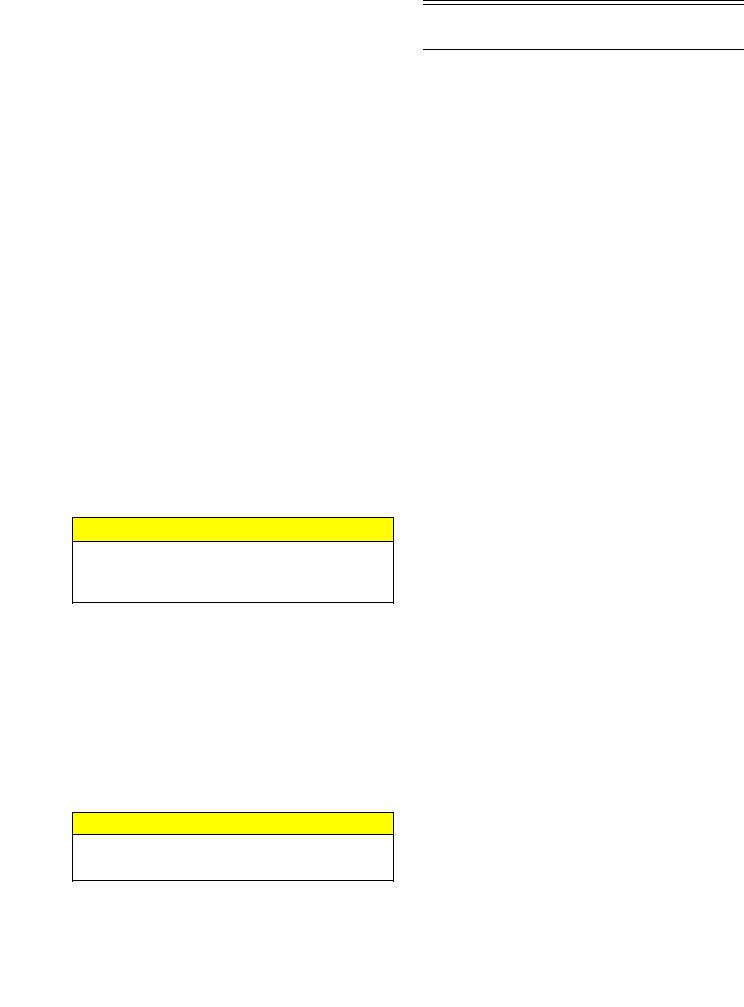
B.Pour 29.5 mL (1 fl oz) of SAE 30 petro- leum-based oil into each spark plug hole and pull the recoil starter handle slowly about 10 times.
C.Install the spark plugs and connect the high tension leads.
6.Fill the gas tank to its rated capacity; then add Arctic Cat Fuel Stabilizer to the gas tank following directions on the container for the stabilizer/gasoline ratio. Tighten the gas tank cap securely.
7.With the snowmobile level, check the lubricant level in the chain case. If low, add chain lube through the fill plug hole.
8.Remove the drive belt from the drive clutch/driven clutch. Lay the belt on a flat surface or slide it into a cardboard sleeve to prevent warping or distortion during storage; then clean and inspect the drive clutch and driven clutch.
9.Apply light oil to the upper steering post bushings and to the shafts of the shock absorbers; then lubricate the rear suspension with low-temperature grease.
10.Tighten all nuts, bolts, and cap screws making sure all calibrated nuts, bolts, and cap screws are tightened to specifications. Make sure all rivets holding the components together are tight. Replace all loose rivets.
11.Clean and polish the hood, console, and chassis with Cat Cleaner. DO NOT USE SOLVENTS. THE PROPELLENT WILL DAMAGE THE FINISH.
12.On electric start models, disconnect the battery cables making sure to disconnect the negative cable first; then clean the battery posts and cables.
CAUTION
Sealed batteries require charging if left for extended non-start periods. Arctic Cat recommends trickle charging once a month. Follow the manufacturer’s instructions and cautions.
13.If possible, store the snowmobile indoors. Raise the track off the floor by blocking up the back end making sure the snowmobile is secure. Loosen the track adjusting bolts to reduce track tension. Cover the snowmobile with a machine cover or a heavy, ventilated tarpaulin to protect it from dirt and dust.
14.If the snowmobile must be stored outdoors, position the snowmobile out of direct sunlight; then block the entire snowmobile off the ground making sure the snowmobile is secure. Loosen the track adjusting bolts to reduce track tension. Cover with a machine cover or a heavy, ventilated tarpaulin to protect it from dirt, dust, and rain.
CAUTION
Avoid storing in direct sunlight and using a plastic cover as moisture may collect on the snowmobile causing corrosion.
Preparation after Storage
Taking the snowmobile out of storage and correctly preparing it for another season will ensure many miles and hours of trouble-free snowmobiling. Arctic Cat recommends the following procedure:
1.Clean the snowmobile thoroughly. Polish the exterior of the snowmobile.
2.Clean the engine. Remove the cloth from the exhaust system. Check exhaust system and air silencer for obstructions.
3.Inspect all control wires and cables for signs of wear or fraying. Replace if necessary. Use cable ties or tape to route wires and cables away from hot or rotating parts.
4.Inspect the drive belt for cracks and tears. Check belt specifications. Replace if damaged or worn. Install the drive belt.
NOTE: If the old belt is worn but in reasonable condition, retain it with the snowmobile as a spare in case of emergency.
5.Adjust the throttle cable. Inspect all fuel hoses and oil hoses for deterioration or cracks; replace if necessary. Make sure all connections are tight.
6.Fill the oil-injection reservoir with the recommended 2-cycle oil; then inspect each spark plug. Replace, gap, or clean as necessary.
7.Tighten all nuts, bolts, and cap screws making sure all calibrated nuts, bolts, and cap screws are tightened to specifications.
8.If not done during preparation for storage, lubricate the rear suspension with low-temperature grease.
9.Check the coolant level and all coolant hoses and connections for deterioration or cracks. Add properly mixed coolant as necessary.
10.On electric start models, charge the battery; then connect the battery cables making sure to connect the positive cable first. Test the electric start system.
11.Inspect the entire brake system, all controls, headlight, taillight, brake light, ski wear bars, and headlight aim; adjust or replace as necessary.
12.Adjust the track to the proper tension and alignment.
5

After Break-In
Checkup/Checklist
Certain areas require adjustment after the break-in period in order to obtain peak performance. These areas are the following:
DRIVE CLUTCH/DRIVEN CLUTCH ALIGNMENT (OFFSET) — The alignment between the drive clutch and driven clutch are set at the factory. Normally, no adjustment is necessary; however, if premature drive belt wear or poor performance is experienced, the drive clutch/driven clutch alignment must be checked. See “CHECKING OFFSET” in the Drivetrain section in this manual.
TRACK TENSION AND ALIGNMENT — A certain amount of stretch occurs on all tracks during the first 500 miles (800 km). The track must be inspected/adjusted after the first 50 to 100 miles (80 to 160 km) to the specifications given in the Track Specifications sub-section of this section and periodically thereafter. If these adjustments aren’t performed, the track may “derail” which leads to track and slide rail damage.
Along with these major areas, other areas should be checked and adjusted.
Below is a list of items to check after the break-in period. The recommended mileage for this inspection is between 100 and 300 miles (160 and 480 km).
Check drive clutch/driven clutch alignment Adjust track tension and alignment Check throttle cable tension
Check engine idle Check coolant level
Check chain case lubricant level
Check lights (high/low beam, brake light) Check safety switch operation
Check engine compartment for any rubbing components
Check steering hardware for tightness
Check skid frame and A-arm mounting hardware for tightness
Check brake lever travel and adjustment Grease all lubrication points
Engine Specifications
6000
ITEM |
|
Engine Number |
0962-011 |
Displacement |
599 cc |
Bore x Stroke |
73.8 x 70 mm |
Compression Ratio |
6.62:1 |
Cooling System |
Liquid |
Ignition Timing (Engine Warm) |
16.5° @ 2000 RPM |
Spark Plug (NGK) |
BPR9ES |
Spark Plug Gap |
0.028-0.031 in. |
Piston Skirt/Cylinder Clearance |
0.0041-0.0053 in. |
Piston Ring End Gap |
0.012-0.0196 in. |
Cylinder Trueness Limit |
0.004 in. |
Piston Pin Diameter |
0.8659-0.8661 in. |
Piston Pin Bore Diameter |
0.8661-0.8665 in. |
Connecting Rod Small End Bore |
1.0631-1.0634 in. |
Connecting Rod Radial Play |
0.0001-0.0008 in. |
Crankshaft Runout (t.i.r.) |
0.002 in. |
Crankshaft End Play |
0.008 in. |
8000
ITEM |
|
Engine Number (Early Build Models) |
0962-055 |
Engine Number |
0962-109 |
Displacement |
794 cc |
Bore x Stroke |
85 x 70 |
Compression Ratio (Early Build Models) |
6.48:1 |
Compression Ratio |
6.60:1 |
Cooling System |
Liquid |
Ignition Timing (Engine Warm) |
19° @ 1750 RPM |
Spark Plug (NGK) |
BPR9ES |
Spark Plug Gap |
0.028-0.031 in. |
Piston Skirt/Cylinder Clearance |
0.0041-0.0053 in. |
Piston Ring End Gap |
0.012-0.0196 in. |
Cylinder Trueness Limit |
0.004 in. |
Piston Pin Diameter |
0.8659-0.8661 in. |
Piston Pin Bore Diameter |
0.8661-0.8665 in. |
Connecting Rod Small End Bore |
1.0631-1.0634 in. |
Connecting Rod Radial Play |
0.0001-0.0008 in. |
Crankshaft Runout (t.i.r.) |
0.002 in. |
Crankshaft End Play |
0.008 in. |
6
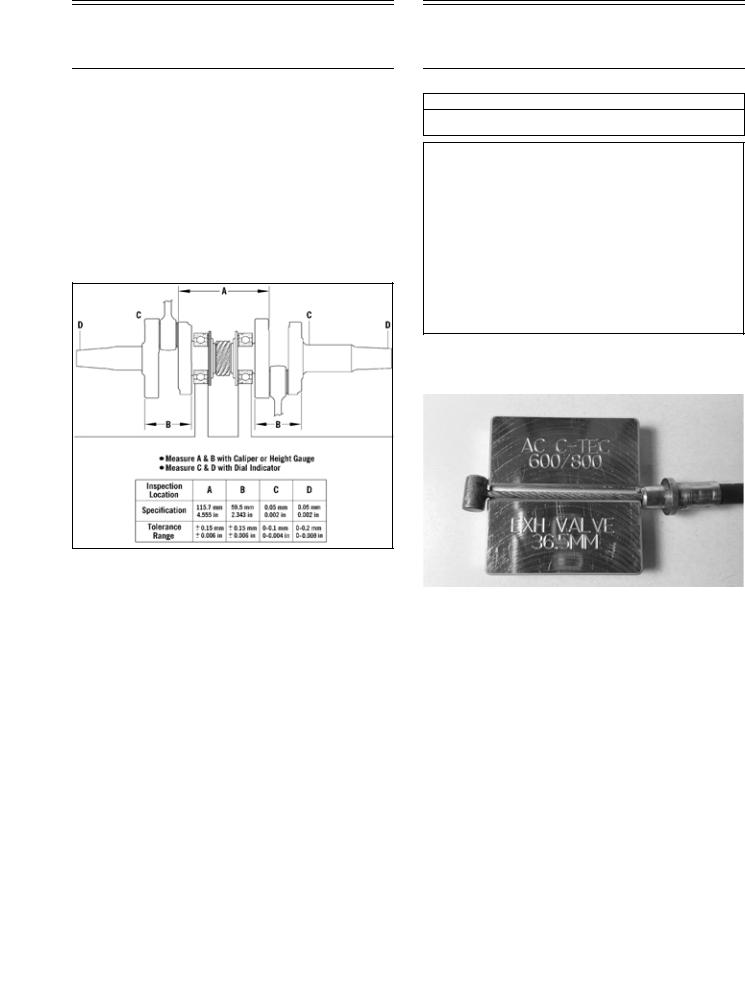
Crankshaft Runout/Repair
Specifications
Refer to the drawing; then find the letter indicating the specification and refer to the chart below the illustration.
NOTE: The proper location for checking crankshaft runout is the very edge of the straight portion of the shaft where the oil seal makes contact. From the illustration, note that three check points are called out: at either end, out on the taper as shown, and also on the center bearing race. The crankshaft is still supported on the outer bearings using V Blocks.
NOTE: The crankshaft must be supported on the inner bearings using V Blocks.
0747-810
Arctic Power Valve (APV)
System Specifications
APV CABLE LENGTH
36.5 mm ± 1 mm
0735-516
The exhaust valve cable length can be measured using a specific gauge (p/n 8639-126).
ZR-250
7
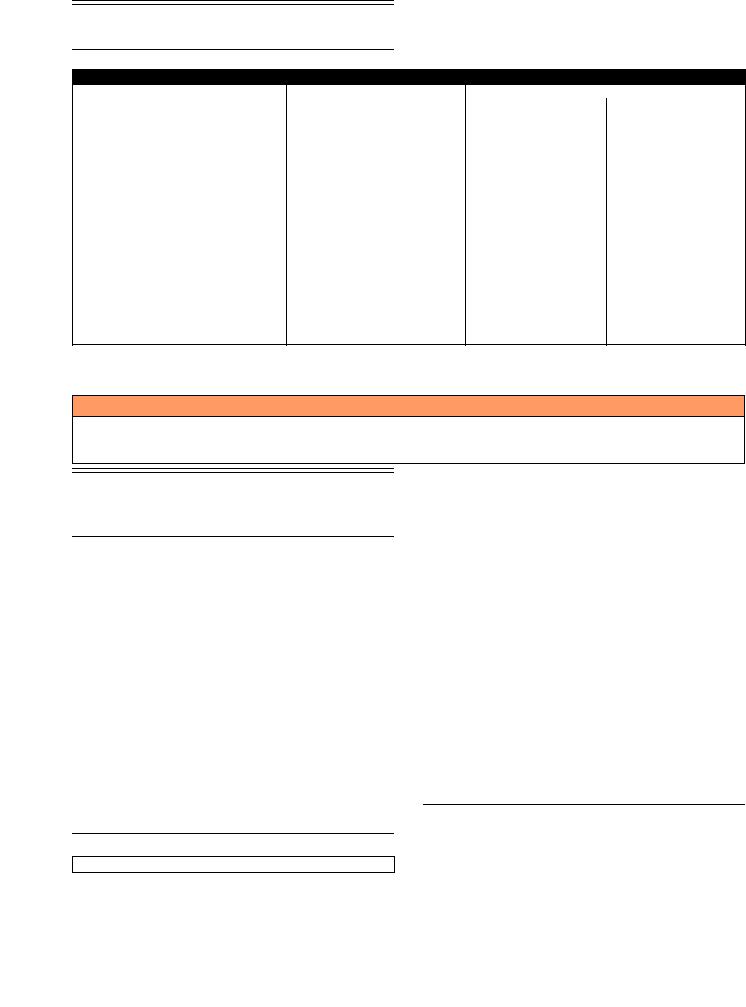
Electrical Specifications
6000/8000 (Normally Open Ignition)
Component |
|
Test Value |
+ Test Connections - |
|
Spark Plug Cap |
|
4000-6000 ohms |
cap end |
cap end |
Oil Level Sensor |
|
Less than 1 ohm (float end down) |
terminal |
terminal |
Ignition Switch |
|
Less than 1 ohm (key in OFF position) terminal |
terminal |
|
Ignition Coil |
(Primary) |
0.24-0.36 ohm |
black/white |
white/blue |
|
(Secondary) |
5040-7560 ohms |
high tension wire |
ground |
Charge Coil (1) |
|
8.8-13.2 ohms |
black/red |
green/red |
Charge Coil (2) |
|
8.8-13.2 ohms |
brown/white |
green/red |
Lighting Coil |
|
0.08-0.12 ohm |
yellow |
yellow |
Ignition Timing Sensor (1) |
|
148-222 ohms |
green/white |
brown/green |
Ignition Timing Sensor (2) |
|
148-222 ohms |
green/white |
brown/green |
Fuel Injector |
|
11.4-12.6 ohms |
terminal |
terminal |
Injection Coil |
|
15.2-22.8 ohms |
blue/white |
blue/white |
Fuel Pump Coil |
|
1.52-2.28 ohms |
orange |
orange |
Servomotor (6000/8000 Early Build Models) |
12 DC Volts |
red/black (counterclockwise) |
black/red (counterclockwise) |
|
|
|
|
black/red (clockwise) |
red/black (clockwise) |
Servomotor (8000) |
|
12 DC Volts |
red/brown (counterclockwise) |
brown/red (counterclockwise) |
|
|
|
brown/red (clockwise) |
red/brown (clockwise) |
Voltage Regulator/Rectifier* |
|
9-15 DC Volts |
red/blue |
black |
* Harness plugged in
NOTE: Lighting coil output is unregulated voltage.
! WARNING
Most voltages generated by the ignition system are sufficient to interrupt pacemakers! All technicians, especially those using pacemakers, must avoid contact with all electrical connections when pulling the recoil starter rope or after the engine has been started.
Drive System
Specifications
Model |
Altitude |
Drive Clutch |
Cam |
Driven |
Torque |
Drive |
Engagement |
Peak |
Top |
Bottom |
Chain |
||
Clutch |
|||||||||||||
|
|
Spring |
Arm |
Spring |
Bracket |
Belt |
RPM |
RPM |
Gear |
Gear |
Pitch |
||
|
|
|
|
|
|
|
|
|
|
|
|
||
ZR 6000 |
0-5000 |
85/275 lb |
68g |
155/220 lb |
48S ERI2 |
0627-107 |
42-4600 |
81-8200 |
22T |
48T |
90 |
||
ZR 6000 R XC |
0-5000 |
120/265 lb |
66g |
155/222 lb |
38S ER/40S ER |
0627-107 |
42-4600 |
81-8200 |
23T |
40T |
86 |
||
ZR 8000 |
0-5000 |
180/240 lb |
74g |
180/240 lb |
64-49-.20 ERI2 |
0627-111 |
38-4000 |
81-8200 |
21T |
41T |
86 |
||
Norseman X 8000 |
0-5000 |
120/265 lb |
74g |
155/220 lb |
48S ERI2 |
0627-111 |
38-4000 |
81-8200 |
19T |
50T |
90 |
||
Riot 6000 |
0-5000 |
85/275 lb |
68g |
155/220 lb |
48S ERI2 |
0627-107 |
42-4600 |
81-8200 |
22T |
48T |
90 |
||
Riot 8000 |
0-5000 |
120/265 lb |
74g |
180/240 lb |
56-49-.20 ERI3 |
0627-111 |
42-4600 |
81-8200 |
22T |
48T |
90 |
||
Riot X 8000 |
0-5000 |
120/265 lb |
74g |
180/240 lb |
56-49-.20 ERI3 |
0627-111 |
42-4600 |
81-8200 |
19T |
50T |
96 |
||
Alpha One 6000 |
6-8000 |
85/275 lb |
68g |
180/240 lb |
48S ERI2 |
0627-107 |
42-4600 |
81-8200 |
19T |
50T |
96 |
||
Alpha One 8000 |
6-8000 |
120/265 lb |
70g |
180/240 lb |
48S ERI2 |
0627-111 |
33-3400 |
81-8200 |
19T |
50T |
96 |
||
|
|
|
|
|
|
|
|
|
|
|
|
|
|
|
|
|
|
|
|
|
|
|
|
|
|
|
|
|
|
|
|
|
|
|
|
|
|
|
|
|
|
|
|
|
|
|
|
|
|
|
|
|
|
|
|
Drive Clutch/Driven
Clutch-Related
Specifications
ALIGNMENT BAR
Offset P/N |
Center-to-Center |
Offset |
Float |
0744-097 |
12.20” |
1.500” |
None |
|
(31 cm) |
(3.8 cm) |
|
Drive System Components
A list of drive system components that are available through the Arctic Cat Service Parts Department can be found in the Quick Reference Guide. This information will be useful when doing any fine-tuning on the drive system.
8

Chain Case Performance
Calibrations
Drive |
Gear |
Ratio Chain |
|
|
|
|
|
|
Engine RPM |
|
|
|
|
|
|
|||||
Sprocket |
Ratio |
|
|
|
|
|
|
|
|
|
|
|
|
|||||||
|
|
|
|
|
|
|
|
|
|
|
|
|
|
|
|
|
|
|||
|
Top |
Btm |
|
|
6200 |
6400 |
6600 |
6800 |
7000 |
7200 |
7400 |
7600 |
7800 |
|
8000 |
8200 |
8400 |
8600 |
8800 |
9000 |
|
|
|
|
|
|
|
|
|
Vehicle Speed (mph) |
|
|
|
|
|
|
|||||
|
|
|
|
|
|
|
|
|
|
|
|
|
|
|
|
|
||||
7 Tooth |
19 |
50 |
0.380 |
90 |
52 |
54 |
56 |
58 |
59 |
61 |
63 |
64 |
66 |
|
68 |
69 |
71 |
73 |
74 |
76 |
(3.0” pitch) |
|
|
|
|
|
|
|
|
|
|
|
|
|
|
|
|
|
|
|
|
21 |
49 |
0.429 |
90 |
59 |
61 |
63 |
65 |
67 |
69 |
71 |
73 |
74 |
|
76 |
78 |
80 |
82 |
84 |
86 |
|
|
20 |
46 |
0.435 |
88 |
60 |
62 |
64 |
66 |
68 |
70 |
72 |
74 |
75 |
|
77 |
79 |
81 |
83 |
85 |
87 |
|
23 |
51 |
0.451 |
92 |
62 |
64 |
66 |
68 |
70 |
72 |
74 |
76 |
78 |
|
80 |
82 |
84 |
86 |
88 |
90 |
|
22 |
48 |
0.458 |
90 |
63 |
65 |
67 |
69 |
71 |
73 |
76 |
78 |
80 |
|
82 |
84 |
86 |
88 |
90 |
92 |
|
24 |
50 |
0.480 |
92 |
66 |
68 |
71 |
73 |
75 |
77 |
79 |
81 |
83 |
|
85 |
88 |
90 |
92 |
94 |
96 |
|
21 |
41 |
0.512 |
86 |
71 |
73 |
75 |
78 |
80 |
82 |
84 |
87 |
89 |
|
91 |
93 |
96 |
98 |
100 |
103 |
|
21 |
38 |
0.553 |
84 |
76 |
79 |
81 |
84 |
86 |
89 |
91 |
93 |
96 |
|
98 |
101 |
103 |
106 |
108 |
111 |
|
20 |
35 |
0.571 |
82 |
79 |
81 |
84 |
87 |
89 |
92 |
94 |
97 |
99 |
|
102 |
104 |
107 |
109 |
112 |
114 |
|
23 |
40 |
0.575 |
86 |
79 |
82 |
84 |
87 |
90 |
92 |
95 |
97 |
100 |
|
102 |
105 |
108 |
110 |
113 |
115 |
|
22 |
37 |
0.595 |
84 |
82 |
85 |
87 |
90 |
93 |
95 |
98 |
101 |
103 |
|
106 |
109 |
111 |
114 |
116 |
119 |
|
24 |
39 |
0.615 |
86 |
85 |
88 |
90 |
93 |
96 |
99 |
101 |
104 |
107 |
|
110 |
112 |
115 |
118 |
121 |
123 |
|
23 |
36 |
0.639 |
84 |
88 |
91 |
94 |
97 |
100 |
102 |
105 |
108 |
111 |
|
114 |
117 |
119 |
122 |
125 |
128 |
|
24 |
35 |
0.686 |
84 |
95 |
98 |
101 |
104 |
107 |
110 |
113 |
116 |
119 |
|
122 |
125 |
128 |
131 |
134 |
137 |
8 Tooth |
19 |
50 |
0.380 |
90 |
57 |
59 |
61 |
63 |
65 |
66 |
68 |
70 |
72 |
|
74 |
76 |
77 |
79 |
81 |
83 |
(2.86” pitch) |
|
|
|
|
|
|
|
|
|
|
|
|
|
|
|
|
|
|
|
|
21 |
49 |
0.429 |
90 |
64 |
67 |
69 |
71 |
73 |
75 |
77 |
79 |
81 |
|
83 |
85 |
87 |
89 |
91 |
94 |
|
|
20 |
46 |
0.435 |
88 |
65 |
67 |
70 |
72 |
74 |
76 |
78 |
80 |
82 |
|
84 |
86 |
89 |
91 |
93 |
95 |
|
23 |
51 |
0.451 |
92 |
68 |
70 |
72 |
74 |
77 |
79 |
81 |
83 |
85 |
|
88 |
90 |
92 |
94 |
96 |
98 |
|
22 |
48 |
0.458 |
90 |
69 |
71 |
73 |
76 |
78 |
80 |
82 |
84 |
87 |
|
89 |
91 |
93 |
96 |
98 |
100 |
|
24 |
50 |
0.480 |
92 |
72 |
75 |
77 |
79 |
81 |
84 |
86 |
88 |
91 |
|
93 |
95 |
98 |
100 |
102 |
105 |
|
21 |
41 |
0.512 |
86 |
77 |
80 |
82 |
84 |
87 |
89 |
92 |
94 |
97 |
|
99 |
102 |
104 |
107 |
109 |
112 |
|
21 |
38 |
0.553 |
84 |
83 |
86 |
88 |
91 |
94 |
97 |
99 |
102 |
105 |
|
107 |
110 |
113 |
115 |
118 |
121 |
|
20 |
35 |
0.571 |
82 |
86 |
89 |
91 |
94 |
97 |
100 |
103 |
105 |
108 |
|
111 |
114 |
116 |
119 |
122 |
125 |
|
23 |
40 |
0.575 |
86 |
86 |
89 |
92 |
95 |
98 |
100 |
103 |
106 |
109 |
|
112 |
114 |
117 |
120 |
123 |
126 |
|
22 |
37 |
0.595 |
84 |
89 |
92 |
95 |
98 |
101 |
104 |
107 |
110 |
112 |
|
115 |
118 |
121 |
124 |
127 |
130 |
|
24 |
39 |
0.615 |
86 |
93 |
96 |
99 |
101 |
104 |
107 |
110 |
113 |
116 |
|
119 |
122 |
125 |
128 |
131 |
134 |
|
23 |
36 |
0.639 |
84 |
96 |
99 |
102 |
105 |
108 |
112 |
115 |
118 |
121 |
|
124 |
127 |
130 |
133 |
136 |
139 |
|
24 |
35 |
0.686 |
84 |
103 |
106 |
110 |
113 |
116 |
120 |
123 |
126 |
130 |
|
133 |
136 |
140 |
143 |
146 |
150 |
8 Tooth |
19 |
50 |
0.380 |
90 |
60 |
62 |
64 |
66 |
68 |
70 |
72 |
73 |
75 |
|
77 |
79 |
81 |
83 |
85 |
87 |
(3.0” pitch) |
|
|
|
|
|
|
|
|
|
|
|
|
|
|
|
|
|
|
|
|
21 |
49 |
0.429 |
90 |
68 |
70 |
72 |
74 |
76 |
79 |
81 |
83 |
85 |
|
87 |
89 |
92 |
94 |
96 |
98 |
|
|
20 |
46 |
0.435 |
88 |
69 |
71 |
73 |
75 |
77 |
80 |
82 |
84 |
86 |
|
88 |
91 |
93 |
95 |
97 |
100 |
|
23 |
51 |
0.451 |
92 |
71 |
73 |
76 |
78 |
80 |
83 |
85 |
87 |
89 |
|
92 |
94 |
96 |
99 |
101 |
103 |
|
22 |
48 |
0.458 |
90 |
72 |
75 |
77 |
79 |
82 |
84 |
86 |
89 |
91 |
|
93 |
96 |
98 |
100 |
103 |
105 |
|
24 |
50 |
0.480 |
92 |
76 |
78 |
81 |
83 |
85 |
88 |
90 |
93 |
95 |
|
98 |
100 |
103 |
105 |
107 |
110 |
|
21 |
41 |
0.512 |
86 |
81 |
83 |
86 |
89 |
91 |
94 |
96 |
99 |
102 |
|
104 |
107 |
109 |
112 |
115 |
117 |
|
21 |
38 |
0.553 |
84 |
87 |
90 |
93 |
96 |
98 |
101 |
104 |
107 |
110 |
|
112 |
115 |
118 |
121 |
124 |
127 |
|
20 |
35 |
0.571 |
82 |
90 |
93 |
96 |
99 |
102 |
105 |
108 |
110 |
113 |
|
116 |
119 |
122 |
125 |
128 |
131 |
|
23 |
40 |
0.575 |
86 |
91 |
94 |
97 |
99 |
102 |
105 |
108 |
111 |
114 |
|
117 |
120 |
123 |
126 |
129 |
132 |
|
22 |
37 |
0.595 |
84 |
94 |
97 |
100 |
103 |
106 |
109 |
112 |
115 |
118 |
|
121 |
124 |
127 |
130 |
133 |
136 |
|
24 |
39 |
0.615 |
86 |
97 |
100 |
103 |
106 |
110 |
113 |
116 |
119 |
122 |
|
125 |
128 |
132 |
135 |
138 |
141 |
|
23 |
36 |
0.639 |
84 |
101 |
104 |
107 |
111 |
114 |
117 |
120 |
124 |
127 |
|
130 |
133 |
137 |
140 |
143 |
146 |
|
24 |
35 |
0.686 |
84 |
108 |
112 |
115 |
119 |
122 |
126 |
129 |
133 |
136 |
|
140 |
143 |
147 |
150 |
154 |
157 |
9 Tooth |
19 |
50 |
0.380 |
90 |
57 |
58 |
60 |
62 |
64 |
66 |
68 |
69 |
71 |
|
73 |
75 |
77 |
79 |
80 |
82 |
(2.52” pitch) |
|
|
|
|
|
|
|
|
|
|
|
|
|
|
|
|
|
|
|
|
21 |
49 |
0.429 |
90 |
64 |
66 |
68 |
70 |
72 |
74 |
76 |
78 |
80 |
|
82 |
84 |
87 |
89 |
91 |
93 |
|
|
20 |
46 |
0.435 |
88 |
65 |
67 |
69 |
71 |
73 |
75 |
77 |
79 |
82 |
|
84 |
86 |
88 |
90 |
92 |
94 |
|
23 |
51 |
0.451 |
92 |
67 |
69 |
72 |
74 |
76 |
78 |
80 |
82 |
85 |
|
87 |
89 |
91 |
93 |
95 |
98 |
|
22 |
48 |
0.458 |
90 |
68 |
71 |
73 |
75 |
77 |
79 |
82 |
84 |
86 |
|
88 |
90 |
93 |
95 |
97 |
99 |
|
24 |
50 |
0.480 |
92 |
72 |
74 |
76 |
78 |
81 |
83 |
85 |
88 |
90 |
|
92 |
95 |
97 |
99 |
102 |
104 |
|
21 |
41 |
0.512 |
86 |
76 |
79 |
81 |
84 |
86 |
89 |
91 |
94 |
96 |
|
99 |
101 |
103 |
106 |
108 |
111 |
|
21 |
38 |
0.553 |
84 |
82 |
85 |
88 |
90 |
93 |
96 |
98 |
101 |
104 |
|
106 |
109 |
112 |
114 |
117 |
120 |
|
20 |
35 |
0.571 |
82 |
85 |
88 |
91 |
93 |
96 |
99 |
102 |
104 |
107 |
|
110 |
113 |
115 |
118 |
121 |
124 |
|
23 |
40 |
0.575 |
86 |
86 |
88 |
91 |
94 |
97 |
100 |
102 |
105 |
108 |
|
111 |
113 |
116 |
119 |
122 |
124 |
|
22 |
37 |
0.595 |
84 |
89 |
91 |
94 |
97 |
100 |
103 |
106 |
109 |
112 |
|
114 |
117 |
120 |
123 |
126 |
129 |
|
24 |
39 |
0.615 |
86 |
92 |
95 |
98 |
101 |
104 |
107 |
109 |
112 |
115 |
|
118 |
121 |
124 |
127 |
130 |
133 |
|
23 |
36 |
0.639 |
84 |
95 |
98 |
101 |
104 |
108 |
111 |
114 |
117 |
120 |
|
123 |
126 |
129 |
132 |
135 |
138 |
|
24 |
35 |
0.686 |
84 |
102 |
106 |
109 |
112 |
115 |
119 |
122 |
125 |
129 |
|
132 |
135 |
138 |
142 |
145 |
148 |
9
Drive |
Gear |
Ratio Chain |
|
|
|
|
|
|
Engine RPM |
|
|
|
|
|
|
|||||
Sprocket |
Ratio |
|
|
|
|
|
|
|
|
|
|
|
|
|||||||
|
|
|
|
|
|
|
|
|
|
|
|
|
|
|
|
|
|
|||
|
Top |
Btm |
|
|
6200 |
6400 |
6600 |
6800 |
7000 |
7200 |
7400 |
7600 |
7800 |
|
8000 |
8200 |
8400 |
8600 |
8800 |
9000 |
|
|
|
|
|
|
|
|
|
Vehicle Speed (mph) |
|
|
|
|
|
|
|||||
|
|
|
|
|
|
|
|
|
|
|
|
|
|
|
|
|
||||
9 Tooth |
19 |
50 |
0.380 |
90 |
64 |
66 |
68 |
71 |
73 |
75 |
77 |
79 |
81 |
|
83 |
85 |
87 |
89 |
91 |
93 |
(2.86” pitch) |
|
|
|
|
|
|
|
|
|
|
|
|
|
|
|
|
|
|
|
|
21 |
49 |
0.429 |
90 |
73 |
75 |
77 |
80 |
82 |
84 |
87 |
89 |
91 |
|
94 |
96 |
98 |
101 |
103 |
105 |
|
|
20 |
46 |
0.435 |
88 |
74 |
76 |
78 |
81 |
83 |
85 |
88 |
90 |
93 |
|
95 |
97 |
100 |
102 |
104 |
107 |
|
23 |
51 |
0.451 |
92 |
76 |
79 |
81 |
84 |
86 |
89 |
91 |
94 |
96 |
|
98 |
101 |
103 |
106 |
108 |
111 |
|
22 |
48 |
0.458 |
90 |
78 |
80 |
83 |
85 |
88 |
90 |
93 |
95 |
98 |
|
100 |
103 |
105 |
108 |
110 |
113 |
|
24 |
50 |
0.480 |
92 |
81 |
84 |
86 |
89 |
92 |
94 |
97 |
100 |
102 |
|
105 |
107 |
110 |
113 |
115 |
118 |
|
21 |
41 |
0.512 |
86 |
87 |
89 |
92 |
95 |
98 |
101 |
103 |
106 |
109 |
|
112 |
115 |
117 |
120 |
123 |
126 |
|
21 |
38 |
0.553 |
84 |
93 |
97 |
100 |
103 |
106 |
109 |
112 |
115 |
118 |
|
121 |
124 |
127 |
130 |
133 |
136 |
|
20 |
35 |
0.571 |
82 |
97 |
100 |
103 |
106 |
109 |
112 |
115 |
118 |
122 |
|
125 |
128 |
131 |
134 |
137 |
140 |
|
23 |
40 |
0.575 |
86 |
97 |
100 |
104 |
107 |
110 |
113 |
116 |
119 |
122 |
|
126 |
129 |
132 |
135 |
138 |
141 |
|
22 |
37 |
0.595 |
84 |
101 |
104 |
107 |
110 |
114 |
117 |
120 |
123 |
127 |
|
130 |
133 |
136 |
140 |
143 |
146 |
|
24 |
39 |
0.615 |
86 |
104 |
107 |
111 |
114 |
118 |
121 |
124 |
128 |
131 |
|
134 |
138 |
141 |
144 |
148 |
151 |
|
23 |
36 |
0.639 |
84 |
108 |
112 |
115 |
119 |
122 |
126 |
129 |
132 |
136 |
|
139 |
143 |
146 |
150 |
153 |
157 |
|
24 |
35 |
0.686 |
84 |
116 |
120 |
123 |
127 |
131 |
135 |
138 |
142 |
146 |
|
150 |
153 |
157 |
161 |
165 |
168 |
9 Tooth |
19 |
50 |
0.380 |
88 |
67 |
70 |
72 |
74 |
76 |
78 |
80 |
83 |
85 |
|
87 |
89 |
91 |
94 |
96 |
98 |
(3.0” pitch) |
|
|
|
|
|
|
|
|
|
|
|
|
|
|
|
|
|
|
|
|
21 |
49 |
0.429 |
90 |
76 |
79 |
81 |
83 |
86 |
88 |
91 |
93 |
96 |
|
98 |
101 |
103 |
105 |
108 |
110 |
|
|
20 |
46 |
0.435 |
88 |
77 |
80 |
82 |
85 |
87 |
90 |
92 |
95 |
97 |
|
100 |
102 |
105 |
107 |
110 |
112 |
|
23 |
51 |
0.451 |
92 |
80 |
83 |
85 |
88 |
90 |
93 |
96 |
98 |
101 |
|
103 |
106 |
108 |
111 |
114 |
116 |
|
22 |
48 |
0.458 |
90 |
81 |
84 |
87 |
89 |
92 |
94 |
97 |
100 |
102 |
|
105 |
108 |
110 |
113 |
115 |
118 |
|
24 |
50 |
0.480 |
92 |
85 |
88 |
91 |
93 |
96 |
99 |
102 |
104 |
107 |
|
110 |
113 |
115 |
118 |
121 |
124 |
|
21 |
41 |
0.512 |
86 |
91 |
94 |
97 |
100 |
103 |
106 |
108 |
111 |
114 |
|
117 |
120 |
123 |
126 |
129 |
132 |
|
21 |
38 |
0.553 |
84 |
98 |
101 |
104 |
108 |
111 |
114 |
117 |
120 |
123 |
|
127 |
130 |
133 |
136 |
139 |
142 |
|
20 |
35 |
0.571 |
82 |
101 |
105 |
108 |
111 |
114 |
118 |
121 |
124 |
128 |
|
131 |
134 |
137 |
141 |
144 |
147 |
|
23 |
40 |
0.575 |
86 |
102 |
105 |
109 |
112 |
115 |
118 |
122 |
125 |
128 |
|
132 |
135 |
138 |
142 |
145 |
148 |
|
22 |
37 |
0.595 |
84 |
106 |
109 |
112 |
116 |
119 |
123 |
126 |
129 |
133 |
|
136 |
140 |
143 |
146 |
150 |
153 |
|
24 |
39 |
0.615 |
86 |
109 |
113 |
116 |
120 |
123 |
127 |
130 |
134 |
137 |
|
141 |
144 |
148 |
151 |
155 |
159 |
|
23 |
36 |
0.639 |
84 |
113 |
117 |
121 |
124 |
128 |
132 |
135 |
139 |
143 |
|
146 |
150 |
154 |
157 |
161 |
165 |
|
24 |
35 |
0.686 |
84 |
122 |
126 |
130 |
133 |
137 |
141 |
145 |
149 |
153 |
|
157 |
161 |
165 |
169 |
173 |
177 |
10 Tooth |
19 |
50 |
0.380 |
90 |
63 |
65 |
67 |
69 |
71 |
73 |
75 |
77 |
79 |
|
81 |
83 |
85 |
87 |
89 |
91 |
(2.52” pitch) |
|
|
|
|
|
|
|
|
|
|
|
|
|
|
|
|
|
|
|
|
21 |
49 |
0.429 |
90 |
71 |
73 |
76 |
78 |
80 |
82 |
85 |
87 |
89 |
|
92 |
94 |
96 |
98 |
101 |
103 |
|
|
20 |
46 |
0.435 |
88 |
72 |
74 |
77 |
79 |
81 |
84 |
86 |
88 |
91 |
|
93 |
95 |
98 |
100 |
102 |
105 |
|
23 |
51 |
0.451 |
92 |
75 |
77 |
80 |
82 |
84 |
87 |
89 |
92 |
94 |
|
96 |
99 |
101 |
104 |
106 |
108 |
|
22 |
48 |
0.458 |
90 |
76 |
78 |
81 |
83 |
86 |
88 |
91 |
93 |
96 |
|
98 |
100 |
103 |
105 |
108 |
110 |
|
24 |
50 |
0.480 |
92 |
80 |
82 |
85 |
87 |
90 |
92 |
95 |
97 |
100 |
|
103 |
105 |
108 |
110 |
113 |
115 |
|
21 |
41 |
0.512 |
86 |
85 |
88 |
90 |
93 |
96 |
99 |
101 |
104 |
107 |
|
109 |
112 |
115 |
118 |
120 |
123 |
|
21 |
38 |
0.553 |
84 |
92 |
94 |
97 |
100 |
103 |
106 |
109 |
112 |
115 |
|
118 |
121 |
124 |
127 |
130 |
133 |
|
20 |
35 |
0.571 |
82 |
95 |
98 |
101 |
104 |
107 |
110 |
113 |
116 |
119 |
|
122 |
125 |
128 |
131 |
134 |
137 |
|
23 |
40 |
0.575 |
86 |
95 |
98 |
101 |
104 |
108 |
111 |
114 |
117 |
120 |
|
123 |
126 |
129 |
132 |
135 |
138 |
|
22 |
37 |
0.595 |
84 |
98 |
102 |
105 |
108 |
111 |
114 |
118 |
121 |
124 |
|
127 |
130 |
133 |
137 |
140 |
143 |
|
24 |
39 |
0.615 |
86 |
102 |
105 |
108 |
112 |
115 |
118 |
122 |
125 |
128 |
|
132 |
135 |
138 |
141 |
145 |
148 |
|
23 |
36 |
0.639 |
84 |
106 |
109 |
113 |
116 |
119 |
123 |
126 |
130 |
133 |
|
137 |
140 |
143 |
147 |
150 |
154 |
|
24 |
35 |
0.686 |
84 |
114 |
117 |
121 |
125 |
128 |
132 |
136 |
139 |
143 |
|
147 |
150 |
154 |
158 |
161 |
165 |
8 Tooth |
19 |
50 |
0.380 |
90 |
60 |
62 |
64 |
66 |
68 |
70 |
72 |
73 |
75 |
|
77 |
79 |
81 |
83 |
85 |
87 |
(3.5” pitch) |
|
|
|
|
|
|
|
|
|
|
|
|
|
|
|
|
|
|
|
|
21 |
49 |
0.429 |
90 |
68 |
70 |
72 |
74 |
76 |
79 |
81 |
83 |
85 |
|
87 |
89 |
92 |
94 |
96 |
98 |
|
|
20 |
46 |
0.435 |
88 |
69 |
71 |
73 |
75 |
77 |
80 |
82 |
84 |
86 |
|
88 |
91 |
93 |
95 |
97 |
100 |
|
23 |
51 |
0.451 |
92 |
71 |
73 |
76 |
78 |
80 |
83 |
85 |
87 |
89 |
|
92 |
94 |
96 |
99 |
101 |
103 |
|
22 |
48 |
0.458 |
90 |
72 |
75 |
77 |
79 |
82 |
84 |
86 |
89 |
91 |
|
93 |
96 |
98 |
100 |
103 |
105 |
|
24 |
50 |
0.480 |
92 |
76 |
78 |
81 |
83 |
85 |
88 |
90 |
93 |
95 |
|
98 |
100 |
103 |
105 |
107 |
110 |
|
21 |
41 |
0.512 |
86 |
81 |
83 |
86 |
89 |
91 |
94 |
96 |
99 |
102 |
|
104 |
107 |
109 |
112 |
115 |
117 |
|
21 |
38 |
0.553 |
84 |
87 |
90 |
93 |
96 |
98 |
101 |
104 |
107 |
110 |
|
112 |
115 |
118 |
121 |
124 |
127 |
|
20 |
35 |
0.571 |
82 |
90 |
93 |
96 |
99 |
102 |
105 |
108 |
110 |
113 |
|
116 |
119 |
122 |
125 |
128 |
131 |
|
23 |
40 |
0.575 |
86 |
91 |
94 |
97 |
99 |
102 |
105 |
108 |
111 |
114 |
|
117 |
120 |
123 |
126 |
129 |
132 |
|
22 |
37 |
0.595 |
84 |
94 |
97 |
100 |
103 |
106 |
109 |
112 |
115 |
118 |
|
121 |
124 |
127 |
130 |
133 |
136 |
|
24 |
39 |
0.615 |
86 |
97 |
100 |
103 |
106 |
110 |
113 |
116 |
119 |
122 |
|
125 |
128 |
132 |
135 |
138 |
141 |
|
23 |
36 |
0.639 |
84 |
101 |
104 |
107 |
111 |
114 |
117 |
120 |
124 |
127 |
|
130 |
133 |
137 |
140 |
143 |
146 |
|
24 |
35 |
0.686 |
84 |
108 |
112 |
115 |
119 |
122 |
126 |
129 |
133 |
136 |
|
140 |
143 |
147 |
150 |
154 |
157 |
10
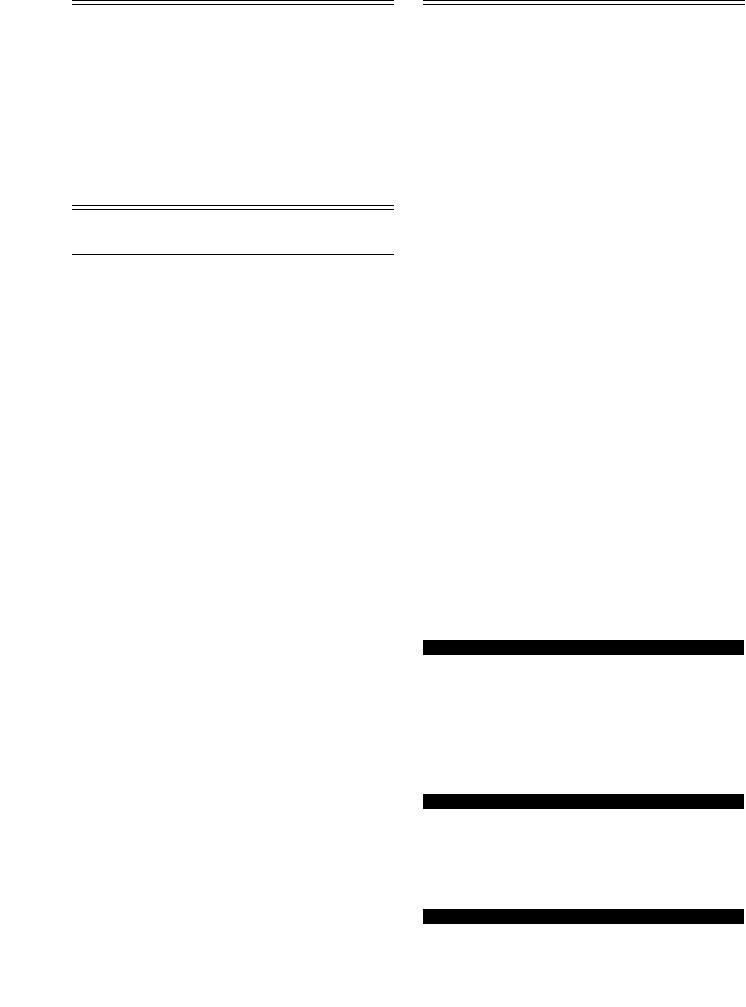
Track Specifications |
|
Torque Specifications |
|
|
|
Model |
Length |
Lug Height |
ZR |
129”/137” |
1.25” |
Riot |
146” |
1.35”/1.6” |
Riot X |
146” |
2.0” |
Alpha One |
154”/165” |
3.0” |
Norseman X |
153” |
2.25” |
NOTE: The track tension on all models should be
20 lb (9 kg) @ 2 inches (50 mm).
Torque Conversions
ft-lb |
N-m |
ft-lb |
N-m |
ft-lb |
N-m |
ft-lb |
N-m |
1 |
1.4 |
26 |
35.4 |
51 |
69.4 |
76 |
103.4 |
2 |
2.7 |
27 |
36.7 |
52 |
70.7 |
77 |
104.7 |
3 |
4.1 |
28 |
38.1 |
53 |
72.1 |
78 |
106.1 |
4 |
5.4 |
29 |
39.4 |
54 |
73.4 |
79 |
107.4 |
5 |
6.8 |
30 |
40.8 |
55 |
74.8 |
80 |
108.8 |
6 |
8.2 |
31 |
42.2 |
56 |
76.2 |
81 |
110.2 |
7 |
9.5 |
32 |
43.5 |
57 |
77.5 |
82 |
111.5 |
8 |
10.9 |
33 |
44.9 |
58 |
78.9 |
83 |
112.9 |
9 |
12.2 |
34 |
46.2 |
59 |
80.2 |
84 |
114.2 |
10 |
13.6 |
35 |
47.6 |
60 |
81.6 |
85 |
115.6 |
11 |
15 |
36 |
49 |
61 |
83 |
86 |
117 |
12 |
16.3 |
37 |
50.3 |
62 |
84.3 |
87 |
118.3 |
13 |
17.7 |
38 |
51.7 |
63 |
85.7 |
88 |
119.7 |
14 |
19 |
39 |
53 |
64 |
87 |
89 |
121 |
15 |
20.4 |
40 |
54.4 |
65 |
88.4 |
90 |
122.4 |
16 |
21.8 |
41 |
55.8 |
66 |
89.8 |
91 |
123.8 |
17 |
23.1 |
42 |
57.1 |
67 |
91.1 |
92 |
125.1 |
18 |
24.5 |
43 |
58.5 |
68 |
92.5 |
93 |
126.5 |
19 |
25.8 |
44 |
59.8 |
69 |
93.8 |
94 |
127.8 |
20 |
27.2 |
45 |
61.2 |
70 |
95.2 |
95 |
129.2 |
21 |
28.6 |
46 |
62.6 |
71 |
96.6 |
96 |
130.6 |
22 |
29.9 |
47 |
63.9 |
72 |
97.9 |
97 |
131.9 |
23 |
31.3 |
48 |
65.3 |
73 |
99.3 |
98 |
133.3 |
24 |
32.6 |
49 |
66.6 |
74 |
100.6 |
99 |
134.6 |
25 |
34 |
50 |
68 |
75 |
102 |
100 |
136 |
NOTE: Torque specifications have the following tolerances:
Torque |
|
|
|
Tolerance |
|
|
0-15 ft-lb (0-20.3 N-m) |
|
±20% |
|
|||
16-39 ft-lb (21.7-52.9 N-m) |
|
±15% |
|
|||
40+ ft-lb (54.2+ N-m) |
|
±10% |
|
|||
|
|
|
|
|
|
|
Item |
|
Secured to |
|
Torque |
Torque |
|
|
|
ft-lb |
(N-m) |
|||
|
|
|
|
|
||
|
DRIVE SYSTEM |
|
|
|
||
Drive Clutch |
|
Engine |
|
51 |
69.4 |
|
Drive Clutch Cover |
|
Movable Sheave |
|
10 |
13.6 |
|
Ring Gear/Damper |
|
Drive Clutch |
|
22 |
29.9 |
|
Spider |
|
Stationary Sheave |
|
450 |
610.1 |
|
Spider Jam Nut |
|
Stationary Sheave |
|
80 |
108.8 |
|
Cam Arm Lock Nut |
|
Cam Arm Screw |
|
50 in.-lb |
5.6 |
|
Driven Clutch |
|
Driven Shaft |
|
60 |
81.6 |
|
Movable Sheave |
|
Torque Bracket |
|
10 |
13.6 |
|
Chain Case (Cap Screw) |
|
Chassis |
|
10 |
13.6 |
|
Chain Case (Torx-Head |
|
Chassis |
|
13 |
17.7 |
|
Screw) |
|
|
|
|
||
|
|
|
|
|
|
|
Chain Case Cover |
|
Chain Case |
|
10 |
13.6 |
|
Brake Caliper |
|
Chassis |
|
25 |
34 |
|
Outside Caliper Housing |
|
Inside Caliper |
|
25 |
34 |
|
|
|
Housing |
|
|
||
|
|
|
|
|
||
Brake Line |
|
Caliper |
|
25 |
34 |
|
Brake Line |
|
Master Cylinder |
|
25 |
34 |
|
Brake Caliper |
|
Shield Cover |
|
96 in.-lb |
10.8 |
|
|
|
STEERING |
|
|
|
|
Ski |
|
Spindle |
|
35 |
47.6 |
|
Ski |
|
Wear Bar |
|
15 |
20.4 |
|
Ski |
|
Ski Handle |
|
54 in.-lb |
6.1 |
|
Steering Support |
|
Mounting Block |
|
96 in.-lb |
10.9 |
|
Steering Tie Rod |
|
Steering Post |
|
55 |
74.8 |
|
Steering Tie Rod |
|
Steering Arm |
|
20 |
27.2 |
|
Steering Post Cap |
|
Riser Block |
|
20 |
27.2 |
|
Steering Post |
|
Chassis |
|
55 |
74.8 |
|
Tie Rod |
|
Steering Arm |
|
20 |
27.2 |
|
Tie Rod |
|
Spindle Arm |
|
32 |
43.5 |
|
Steering Arm |
|
Chassis |
|
96 in.-lb |
10.9 |
|
FRONT SUSPENSION |
|
|
|
|||
|
|
ZR/Riot |
|
|
|
|
A-Arm (Upper) |
|
Chassis |
|
108 in.-lb |
12.2 |
|
A-Arm (Lower) |
|
Chassis (Front) |
|
65 |
88.4 |
|
A-Arm (Lower) |
|
Chassis (Rear) |
|
45 |
61.2 |
|
A-Arm (Upper) |
|
Spindle |
|
20 |
27.2 |
|
A-Arm (Lower) |
|
Spindle |
|
45 |
61.2 |
|
Shock Absorber |
|
A-Arm |
|
32 |
43.5 |
|
Shock Absorber |
|
Chassis |
|
32 |
43.5 |
|
Sway Bar Link |
|
A-Arm/Sway Bar |
|
23 |
31.3 |
|
|
|
Link |
|
|||
|
|
|
|
|
||
Sway Bar Mounting Bracket |
Chassis |
|
108 in.-lb |
12.2 |
||
|
Riot X/Alpha One |
|
|
|
||
A-Arm (Upper) |
|
Chassis |
|
108 in.-lb |
12.2 |
|
A-Arm (Lower) |
|
Chassis (Front) |
|
65 |
88.4 |
|
A-Arm (Lower) |
|
Chassis (Rear) |
|
45 |
61.2 |
|
A-Arm (Upper) |
|
Spindle |
|
20 |
27.2 |
|
A-Arm (Lower) |
|
Spindle |
|
45 |
61.2 |
|
Shock Absorber |
|
A-Arm |
|
24 |
32.6 |
|
Shock Absorber |
|
Chassis |
|
24 |
32.6 |
|
|
|
Norseman X |
|
|
|
|
A-Arm (Upper) |
|
Chassis |
|
23 |
31.3 |
|
A-Arm (Lower) |
|
Chassis (Front) |
|
65 |
88.4 |
|
11
Item |
|
Secured to |
Torque |
Torque |
|
ft-lb |
(N-m) |
||
|
Norseman X (cont.) |
|||
|
|
|
||
A-Arm (Lower) |
|
Chassis (Rear) |
45 |
61.2 |
A-Arm (Upper) |
|
Spindle |
45 |
61.2 |
A-Arm (Lower) |
|
Spindle |
45 |
61.2 |
Shock Absorber |
|
A-Arm |
32 |
43.5 |
Shock Absorber |
|
Chassis |
32 |
43.5 |
Sway Bar Link |
|
A-Arm/Sway Bar |
23 |
31.3 |
|
|
Link |
||
|
|
|
|
|
Sway Bar Mounting Bracket |
Chassis |
108 in.-lb |
12.2 |
|
|
REAR |
SUSPENSION |
|
|
|
|
137”/146” |
|
|
Wear Strip |
|
Rail |
50 in.-lb |
5.6 |
End Cap |
|
Rail |
80 in.-lb |
9.0 |
Coupler Block Axle |
|
Rail |
40 |
54.4 |
Front Arm |
|
Rail |
52 |
70.7 |
Front Slider Axle |
|
Tunnel |
41 |
55.8 |
Front Shock |
|
Rail |
45 |
61.2 |
Front Shock |
|
Front Arm |
40 |
54.4 |
Limiter Strap |
|
Front Arm |
72 in.-lb |
8.1 |
Limiter Strap |
|
Limiter Strap |
72 in.-lb |
8.1 |
Offset Arm |
|
Idler Arm |
20 |
27.2 |
Idler Arm |
|
Rear Arm |
55 |
74.8 |
Rear Wheel Axle |
|
Rail |
35 |
47.6 |
Rear Arm |
|
Rail |
45 |
61.2 |
Rear Shock |
|
Front Arm/Idler Arm |
30 |
40.8 |
Rear Arm |
|
Offset Arm |
45 |
61.2 |
Spring Slide |
|
Rail |
20 |
27.2 |
Offset Arm |
|
Tunnel |
45 |
61.2 |
|
Alpha |
One 146”/154”/165” |
|
|
Wear Strip |
|
Rail |
50 in.-lb |
5.6 |
Idler Wheel |
|
Rail/Shaft |
13 |
17.7 |
Front Arm |
|
Rail |
52 |
70.7 |
Front Shock |
|
Front Arm |
24 |
32.6 |
Front Shock |
|
Rail |
52 |
61.2 |
Rear Arm |
|
Rail |
13 |
17.7 |
Rear Arm |
|
Idler Arm |
24 |
32.6 |
Track Guide |
|
Rear Arm |
24 in.-lb |
2.7 |
Rear Axle |
|
Rail |
24 |
32.6 |
Rear Shock |
|
Idler Arm |
24 |
32.6 |
Rear Shock |
|
Rear Shock Pivot |
24 |
32.6 |
Rear Shock Link |
|
Rear Shock Pivot |
24 |
32.6 |
Rear Shock Link |
|
Idler Arm |
24 |
32.6 |
Limiter Strap |
|
Front Arm |
72 in.-lb |
8.1 |
Limiter Strap |
|
Rail |
15 |
20.4 |
|
|
Norseman X |
|
|
Wear Strip |
|
Rail |
50 in.-lb |
5.6 |
End Cap |
|
Rail |
80 in.-lb |
9.0 |
Mounting Block |
|
Rail |
12 |
16.3 |
Rear Arm |
|
Rail |
45 |
61.2 |
Rear Arm |
|
Idler Arm |
55 |
74.8 |
Spring Slide |
|
Rail |
20 |
27.2 |
Front Arm |
|
Rail |
52 |
70.7 |
Coupler Block Axle |
|
Rail |
40 |
54.4 |
Limiter Strap |
|
Rail Support |
72 in.-lb |
8.1 |
Rear Wheel Axle |
|
Rail |
34 |
46.2 |
Skid Frame |
|
Tunnel |
55 |
74.8 |
Front Shock |
|
Front Arm |
40 |
54.4 |
Front Shock |
|
Rail |
50 |
68 |
Rail Support |
|
Rail |
20 |
27.2 |
Limiter Strap |
|
Front Arm |
72 in.-lb |
8.1 |
Limiter Strap |
|
Rail Support |
72 in.-lb |
8.1 |
12
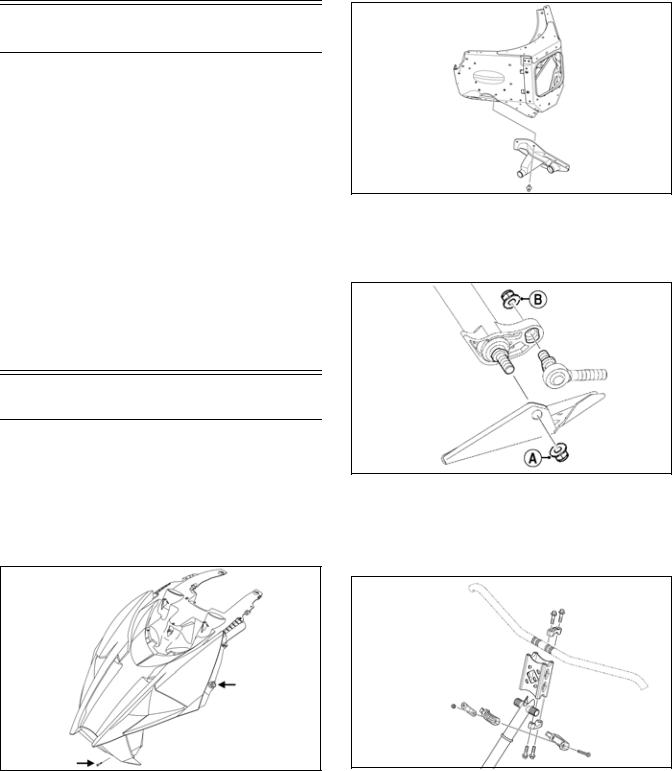
Steering and Body
This section has been organized into sub-sections for servicing steering and body components; however, some components may vary from model to model. The technician should use discretion and sound judgment when removing and installing components.
NOTE: Whenever a part is worn excessively, cracked, or damaged in any way, replacement is necessary.
SPECIAL TOOLS
A number of special tools must be available to the technician when servicing the steering and body systems.
Description |
p/n |
|
|
Handlebar Stand |
5639-152 |
|
|
Steering Post Stand |
5639-946 |
|
|
NOTE: Special tools are available from the Arctic
Cat Service Parts Department.
Steering Post (Laydown)
REMOVING
1.Rotate the two quarter turns to the vertical position; then pull the top of the side panel out and up and off the skid plate.
2.Remove the Torx screw securing the front of the hood to the chassis; then loosen the two quarter turns securing the hood.
0752-484
3.Disconnect the hood harness and remove the hood.
4.Disconnect the exhaust temperature sensor from the main harness; then remove all springs securing the expansion chamber. Remove the expansion chamber.
5.Remove the push rivets securing the right-side steering boot to the chassis. This allows access to the two nuts securing the bottom of the steering post.
SNO-763
6.Remove the nut (A) securing the bottom of the existing steering post to the steering stop bracket; then remove the nut (B) securing the steering tie rod assembly to the steering post. Discard both nuts.
SNO-2221A
7.Remove the cap screws and handlebar caps securing the handlebar to the top of the handlebar riser; then remove the two nuts securing the top of steering post to the chassis. Account for both steering post blocks and retaining plate.
SNO-357
8.Carefully remove the steering post from the snowmobile.
INSTALLING
1.Install steering post into position and secure to the steering stop bracket with a new M10 nut. Be sure to align the steering post ball joint alignment tab with the steering stop bracket. Tighten to 55 ft-lb (74.8 N-m).
13

SNO-2218
2.Secure the tie rod assembly to the steering post using a new M10 nut. Be sure to align the tie rod ball joint alignment tab with the steering post. Tighten to 55 ft-lb (74,8 N-m).
SNO-2219
3.Secure the right-side steering boot to the chassis using the existing push rivets.
SNO-763
4.Secure the top of the steering post to the steering support using the existing retaining plate and nuts. Tighten to 96 in.-lb (10.8 N-m).
5.Install the handlebar riser and handlebar to the top of the steering post and secure using the existing caps and screws. Tighten evenly to 20 ft-lb (27 N-m).
SNO-357
6.Install the expansion chamber using the existing springs; then connect the exhaust temperature sensor to the main harness.
7.Secure the upper wires to the handlebar using two large cable ties; then secure the handlebar wires going to the main harness down the middle left side of the riser using two large cable ties.
ZR-209
8.With the handlebar still turned fully to the right, secure the harness to the open hole in the steering support and the loop (A) using cable ties. Tuck all excess wires and connectors behind the console (B).
ZR-229
9.With the handlebar still turned fully to the right, secure the brake cable to the riser using a large cable tie. Route the cable tie so the connector is inside the riser.
14
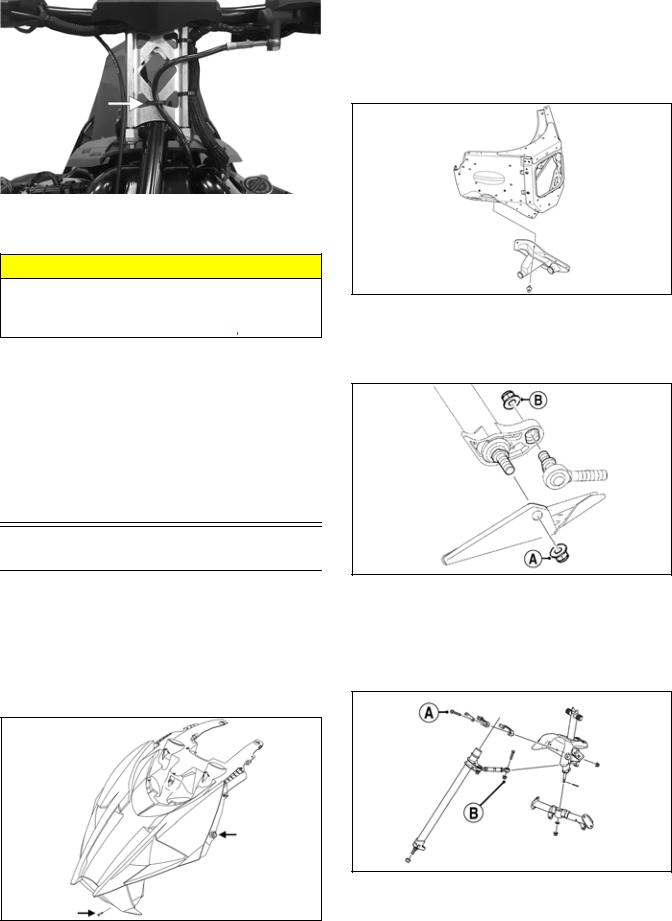
ZR-230
10.Install the handlebar pad making sure the wires are tucked under the pad.
CAUTION
With the handlebar secured and the cable installed, check maximum right/left turning capabilities to ensure that the throttle cables, brake line hose, and harness wires are routed so they do not become pinched or stretched.
NOTE: After installing and adjusting the handlebar, verify that the throttle lever free-play is within specification.
11.Position the hood onto the snowmobile and connect the hood harness connector. Secure the two front quarter-turn fasteners and the Torx screw on the front of the hood.
12.Install the access panels into the skid plates; then close the access panels and secure with the four quar- ter-turn fasteners.
Steering Post (Vertical)
REMOVING
1.Rotate the two quarter turns to the vertical position; then pull the top of the side panel out and slide the panel forward. Remove the panel.
2.Remove the Torx screw securing the front of the hood to the chassis; then loosen the two quarter turns securing the hood.
0752-484
3. Disconnect the hood harness and remove the hood.
4.Disconnect the exhaust temperature sensor from the main harness; then remove all springs securing the expansion chamber. Remove the expansion chamber.
5.Remove the push rivets securing the right-side steering boot to the chassis. This allows access to the two nuts securing the bottom of the steering post.
SNO-763
6.Remove the nut (A) securing the bottom of the existing steering post to the steering stop bracket; then remove the nut (B) securing the steering tie rod assembly to the steering post. Discard both nuts.
SNO-2221A
7.Remove the Torx-head screw and nut (B) securing the tie rod link to the secondary steering post; then remove the two machine screws (A) and nuts securing the top of the secondary steering post to the chassis. Account for both steering post blocks and retaining plate.
SNO-346A
8.Carefully remove the secondary steering post from the snowmobile.
15
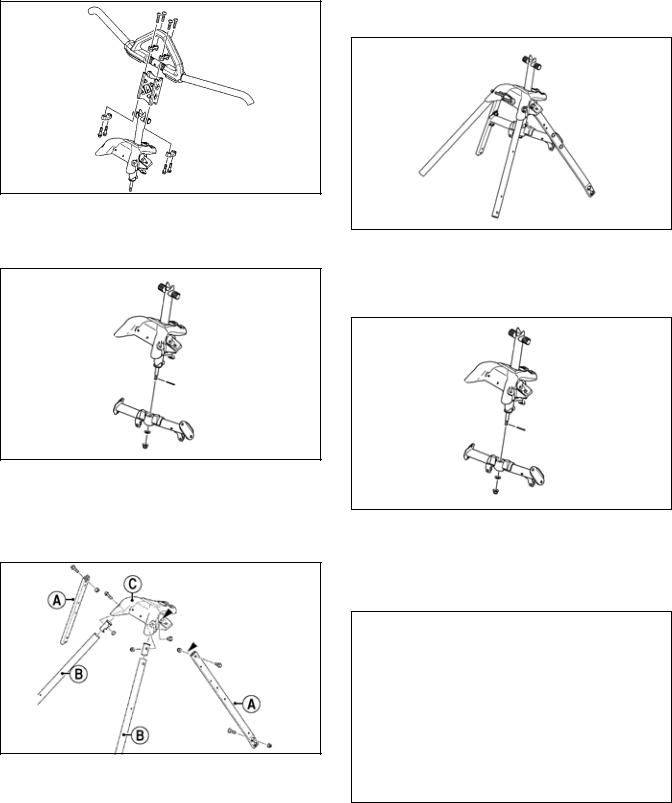
9.Tie the recoil rope in a loose knot to prevent the rope from going into the recoil; then remove the recoil handle from the recoil rope.
10.Remove the eight machine screws and caps securing the handlebar and riser to the fixed steering post assembly.
0747-883
11.Remove and discard the cotter pin securing the fixed steering post; then remove and discard the lock nut but retain the thrust washer.
SNO-333
12.Remove the cap screws securing the existing steering support (C) to the spar tubes (B); then remove the two cap screws securing the steering support to the side support tubes (A). Retain all cap screws but discard all nuts.
SNO-2218
INSPECTING
1.Inspect all welded areas for cracks or deterioration.
2.Inspect the steering post and steering-post retaining plate for cracks, bends, or wear.
3.Inspect the adjuster caps and mounting block for cracks or wear.
INSTALLING
1.Position steering post assembly over the spar tubes, both side supports and into the lower steering support; then secure the assembly using existing cap screws and new nuts. Tighten cap screws to 23 ft-lb (31.3 N-m).
SNO-334
2.Secure the bottom of the steering post to the lower steering support using existing thrust washer and new nyloc nut. Tighten to 20 ft-lb (27.2 N-m). Install Cotter Pin into steering post and spread to secure.
SNO-333
3.Install the secondary steering post into position and secure to the steering stop bracket with a new M10 nut. Be sure to align the steering post ball joint alignment tab with the steering stop bracket.
Tighten to 55 ft-lb (74.8 N-m).
SNO-2218
16
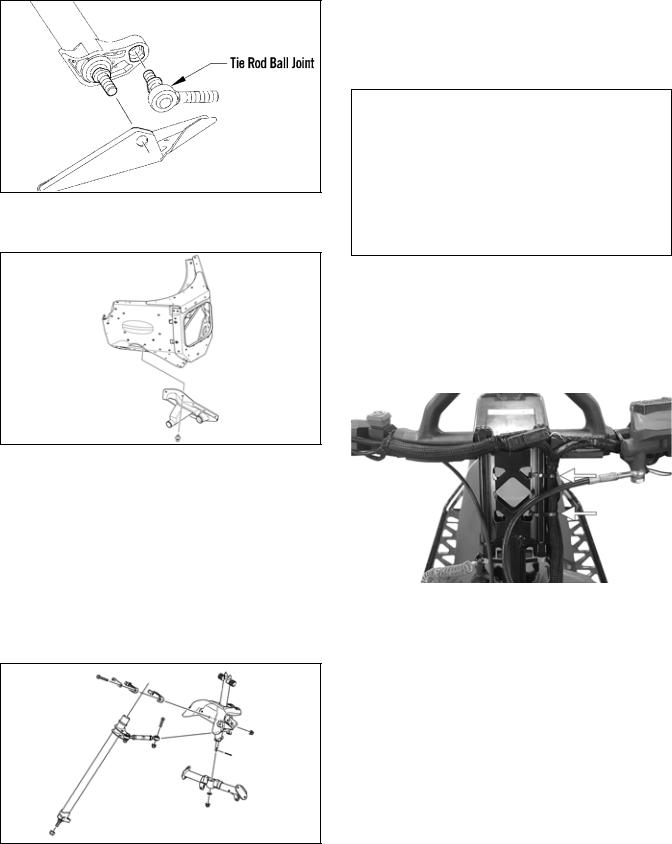
4.Secure the tie rod assembly to the steering post using a new M10 nut. Be sure to align the tie rod ball joint alignment tab with the steering post. Tighten to 55 ft-lb (74.8 N-m).
SNO-2219
5.Secure the right-side steering boot to the chassis using the existing push rivets.
SNO-763
6.Route the recoil rope behind the lower steering support and up through the new steering support and through the existing recoil handle. Tighten rope in a knot.
7.Secure the top of the secondary steering post to the steering support using the existing steering post blocks, machine screws and nuts. Tighten to 8 ft-lb (10.9 N-m).
8.Connect the tie rod from the secondary steering post to the fixed steering post using existing machine screw and new nyloc nut. Tighten to 20 ft-lb (27 N-m).
SNO-346
9.Connect the tie rod (B) from the adjustable steering post to the secondary steering post using the machine screw and nut. Tighten to 20 ft-lb (27 N-m).
10.Install the expansion chamber using the existing springs; then connect the exhaust temperature sensor to the main harness.
11.Position the handlebar to the desired position; then secure using the existing cap and all eight screws. Tighten evenly to 20 ft-lb (27 N-m).
0747-883
12.Install the hood and both access panels.
13.Install three cable ties to secure the handlebar harness to the riser block.
14.Secure the handlebar wires going to the main harness down the middle left side of the riser using two large cable ties.
XM594
15.With the handlebar turned fully to the right, secure the brake cable to the riser using a large cable tie; then install the handlebar pad making sure the wires are tucked under the pad. Secure to the front of the riser using a large cable tie.
17

XM595
CAUTION
With the handlebar secured and the cable installed, check maximum right/left turning capabilities to ensure that the throttle cables, brake line hose, and harness wires are routed so they do not become pinched or stretched.
NOTE: After installing and adjusting the handlebar, verify that the throttle lever free-play is within specification.
Ski (ZR/Riot)
REMOVING
1.Elevate the front of the snowmobile and secure on a support stand.
2.Remove and discard the cotter pin; then remove the nut and cap screw securing the ski to the spindle.
NOTE: Note the orientation of the damper for installation purposes.
3.Remove the ski. Account for the rubber damper and washers.
INSPECTING
1.Inspect the ski for cracks or deterioration.
2.Inspect the ski for abnormal bends or cracks.
3.Inspect the wear bar for wear.
4.Inspect all hardware and the spindle bushings for wear and damage.
5.Inspect the rubber damper for damage or wear.
INSTALLING
1.Slide a washer onto the cap screw used to secure the ski; then apply low-temperature grease to the shaft portion of the cap screw and spindle axle.
2.Install the spindle axle into the spindle; then position the ski damper into the bottom of the ski making sure the damper is properly positioned for the desired ski stance.
ONS-139
ONS-171
NOTE: The ski damper must be positioned in the ski so it is directly under the spindle.
3.With the cap screw hole of the ski centered with the spindle axle, slide the cap screw with washer through the outside of the ski and spindle assemblies.
NOTE: Local laws and/or regulations regarding maximum width of the ski stance may be applicable. Always comply with the maximum width laws and/or regulations when adjusting ski stance.
NOTE: Install the cap screw so the lock nut will be located to the inside of the ski and the cotter pin slot in the cap screw will be horizontal with the ski.
4.Install the remaining washer and lock nut; then tighten the lock nut to 35 ft-lb (47.6 N-m).
NOTE: Ensure that the cotter pin slot in the cap screw is still horizontal with the ski.
5.Install a new cotter pin from the back side of the ski cap screw and spread the pin.
Ski (Norseman X)
REMOVING
1.Elevate the front of the snowmobile and secure on a support stand.
2.Remove and discard the cotter pin; then remove the nut and cap screw securing the ski to the spindle.
3.Remove the ski. Account for the rubber damper and washers.
18
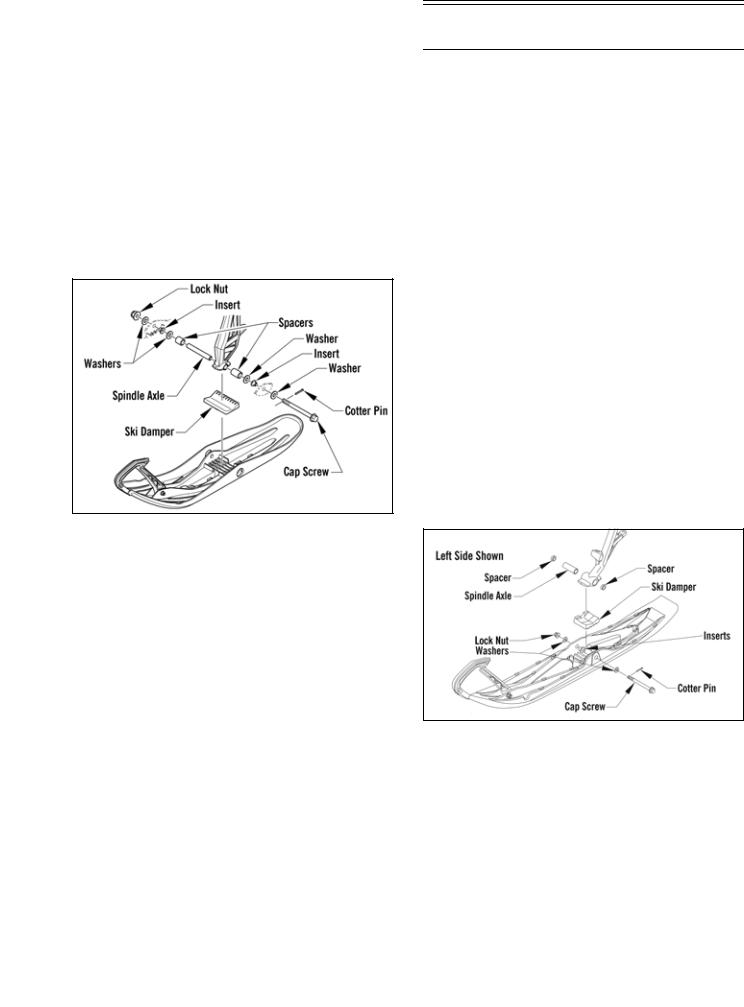
INSPECTING
1.Inspect the ski for cracks or deterioration.
2.Inspect the ski for abnormal bends or cracks.
3.Inspect the wear bar for wear.
4.Inspect all hardware and the spindle bushings for wear and damage.
5.Inspect the rubber damper for damage or wear.
INSTALLING
NOTE: Before installing the skis, make sure the carbide of the split wear bar will be installed toward the inside of the ski when installed on the snowmobile.
1.Slide a washer onto the ski cap screw; then apply low-temperature grease to the cap screw shaft and spindle axle.
0748-981
2.Install the spindle axle into the spindle; then position the ski damper into the ski grooves making sure the grooved side of the damper is installed rearward.
3.Install the spacers and washers onto the spindle axle as follows:
Standard ski stance (one on each side of the spindle) Minimum ski stance (both on the inside of the spindle) Maximum ski stance (both on the outside of the spindle)
4.With the cap screw hole of the ski centered with the spindle axle, slide the cap screw with washer through the outside of the ski.
NOTE: Local laws and/or regulations as to maximum width of the ski stance may be applicable. Always comply with the maximum width laws and/or regulations when adjusting ski stance.
NOTE: Install the cap screw so the lock nut will be located to the inside of the ski and the cotter pin slot in the cap screw will be horizontal with the ski.
5.Install the remaining washers and lock nut; then tighten the lock nut to 35 ft-lb (47.6 N-m). Ensure the cotter pin slot in the cap screw is still horizontal with the ski.
6.Install the cotter pin from the back side of the ski cap screw and spread the pin. Repeat for opposite ski.
Ski (Riot X/Alpha One)
REMOVING
1.Elevate the front of the snowmobile and secure on a support stand.
2.Remove and discard the cotter pin; then remove the nut and cap screw securing the ski to the spindle.
NOTE: Note the orientation of the damper for installation purposes.
3.Remove the ski. Account for the rubber damper, axle, spacers and washers.
INSPECTING
1.Inspect the ski for cracks or deterioration.
2.Inspect the ski for abnormal bends or cracks.
3.Inspect the wear bar for wear.
4.Inspect all hardware and the spindle bushings for wear and damage.
5.Inspect the rubber damper for damage or wear.
INSTALLING
1.Slide a washer onto the cap screw used to secure the ski; then apply low-temperature grease to the shaft portion of the cap screw and spindle axle.
2.Install the spindle axle and spacers into the spindle; then position the ski damper into the bottom of the ski making sure the damper is properly positioned for the desired ski stance.
0752-477
NOTE: The ski damper must be positioned in the ski so it is directly under the spindle.
3.With the cap screw hole of the ski centered with the spindle axle, slide the cap screw with washer through the outside of the ski and spindle assemblies.
NOTE: Install the cap screw so the lock nut will be located to the inside of the ski and the cotter pin slot in the cap screw will be horizontal with the ski.
4.Install the remaining washer and lock nut; then tighten the lock nut to 35 ft-lb (47.6 N-m).
5.Install a new cotter pin from the back side of the ski cap screw and spread the pin.
19
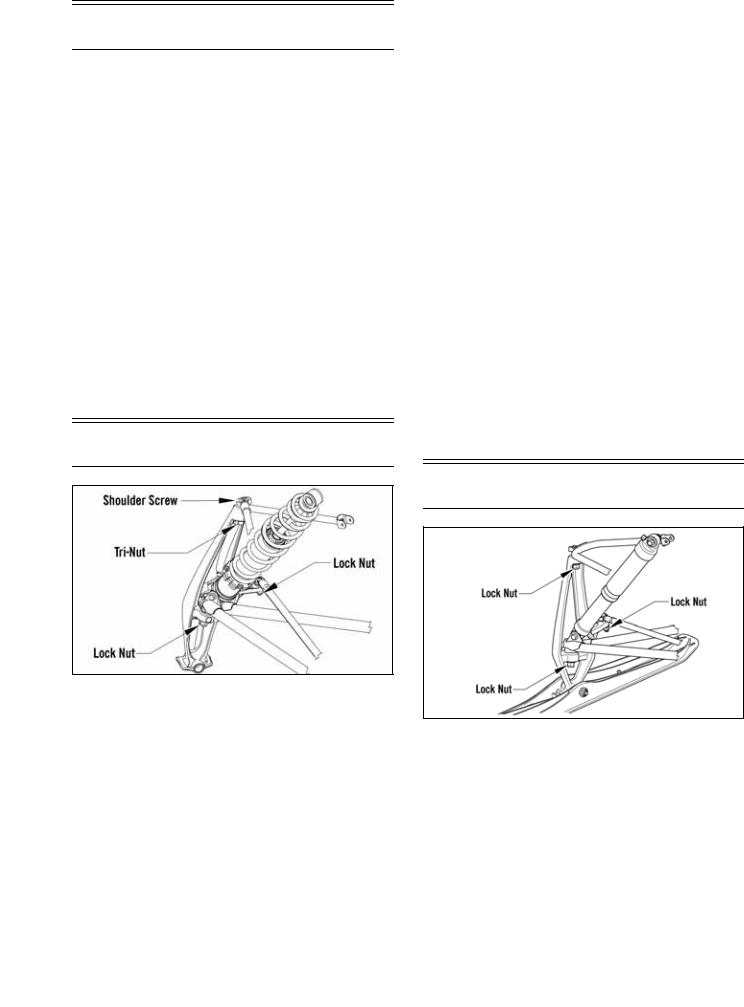
Ski Wear Bar
The ski wear bar is a replaceable bar attached to the underside of the ski. If the snowmobile is operated primarily in deep snow, ski wear bar wear will be minimal; however, if the snowmobile is operated on terrain where the snow cover is minimal, the ski wear bar will wear faster. Arctic Cat recommends that the ski wear bars be replaced if worn to 1/2 of original diameter.
REMOVING
1.Elevate the front of the snowmobile and secure with a suitable stand.
2.Remove the lock nuts securing the wear bar to the ski; then remove the wear bar.
INSTALLING
NOTE: If installing a double-offset wear bar, the carbide edge should be directed to the inside of the ski.
1.Install the wear bar into the ski making sure it is fully seated using a rubber mallet.
2.Secure the wear bar with lock nuts. Tighten to 15 ft-lb (20.4 N-m).
Spindle (ZR/Riot)
ONS-185
REMOVING
1.Position the front of the snowmobile on a safety stand; then remove the ski.
2.Remove the lock nut securing the tie rod to the spindle arm. Account for the washer on the top side.
3.Remove the shoulder screw and the tri-nut securing the upper A-arm to the spindle; then remove the lock nut securing the spindle to the lower A-arm. Using a rubber mallet, remove the spindle from the lower A-arm.
INSPECTING
1.Inspect the spindle for excessive wear, cracks, bends, or imperfections.
2.Inspect the A-arm bushings and axle area for wear.
3.Inspect the ski spindle axle and bearings for wear, damage, or loose fit. Replace the bearings as a set.
NOTE: Replacing the ski bolt bushings is difficult. The existing bushings will be damaged during removal. Be careful, however, not to damage the spindle when removing the bushings. Press the new bushings into the spindle.
INSTALLING
1.Install the lower A-arm into the spindle; then loosely secure with a new lock nut.
2.Position the upper A-arm end with the top of the spindle; then secure the A-arm end to the spindle using the existing shoulder screw and tri-nut. Tighten to 20 ft-lb (27 N-m).
3.Remove the snowmobile from the support stand. Tighten the lower A-arm nut to 45 ft-lb (61.2 N-m).
NOTE: The weight of the snowmobile will allow the ball joint to seat into the spindle before tightening the nut.
4.Place the tie rod with washer into position on the spindle arm. Secure with a new lock nut. Tighten to 32 ft-lb (43.5 N-m).
5.Install the ski using the existing hardware and new cotter pin. Tighten the cap screws to 35 ft-lb (47.6 N-m).
6.Turn the handlebar fully to the right and then to the left to verify the steering moves freely.
Spindle (Norseman X)
ONS-186
REMOVING
1.Position the front of the snowmobile on a safety stand; then remove the ski.
2.Remove the cap screws and lock nuts securing the shock absorber. Account for two axles.
3.Remove the lock nut securing the tie rod to the spindle arm. Account for the washer on the top side.
4.Remove the two lock nuts securing the spindle to the upper and lower A-arms; then using a rubber mallet, remove the arms from the spindle.
5.Remove the spindle.
20
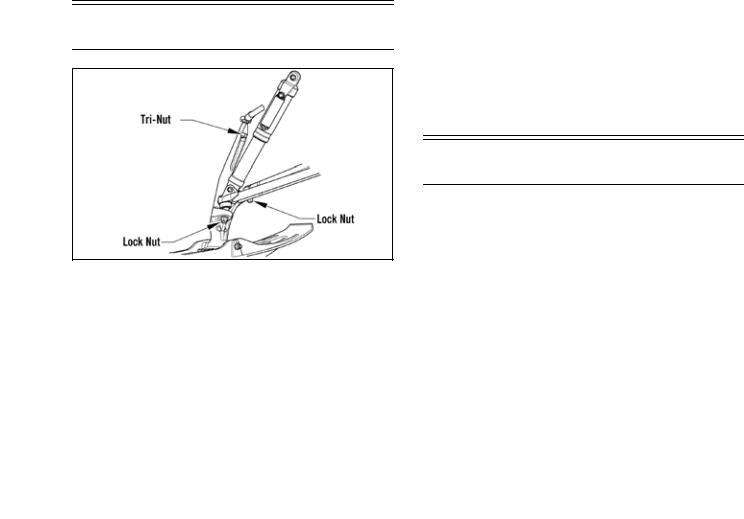
INSPECTING
1.Inspect the spindle for excessive wear, cracks, bends, or imperfections.
2.Inspect the A-arm bushings and axle area for wear.
3.Inspect the ski spindle axle and bearings for wear, damage, or loose fit. Replace the bearings as a set.
NOTE: Replacing the ski bolt bushings is difficult. The existing bushings will be damaged during removal. Be careful, however, not to damage the spindle when removing the bushings. Press the new bushings into the spindle.
INSTALLING
1.Place the shock absorber into position. Secure with the cap screws and new lock nuts. Tighten to 32 ft-lb (43.5 N-m).
2.Install the upper and lower A-arms into the spindle and loosely secure with new lock nuts; then remove the snowmobile from the support stand. Tighten both lock nuts to 45 ft-lb (61.2 N-m).
NOTE: The weight of the snowmobile will allow the ball joints to seat into the spindle before tightening the nuts.
3.Place the tie rod with washer into position on the spindle arm. Secure with a new lock nut. Tighten to 32 ft-lb (43.5 N-m).
4.Install the ski.
5.Turn the handlebar fully to the right and then to the left to verify the steering moves freely.
Spindle (Riot X/Alpha One)
0749-480
REMOVING
1.Position the front of the snowmobile on a safety stand; then remove the ski.
2.Remove the two cap screws and nuts securing the shock to the chassis and to the lower A-arm.
3.Remove the lock nut securing the tie rod to the spindle arm. Account for the washer on the top side.
4.Remove the machine screw and tri-nut securing the upper A-arm ball joint to the spindle.
5.Remove the lock nut securing the spindle to the lower A-arm; then using a rubber mallet, remove the lower arm from the spindle.
INSPECTING
1.Inspect the spindle for excessive wear, cracks, bends, or imperfections.
2.Inspect the A-arm bushings and axle area for wear.
3.Inspect the ski spindle axle and bearings for wear, damage, or loose fit. Replace the bearings as a set.
NOTE: Replacing the ski bushings is difficult. The existing bushings will be damaged during removal. Be careful, however, not to damage the spindle when removing the bushings. Press the new bushings into the spindle.
INSTALLING
1.Install the lower A-arm into the spindle and loosely secure using a new lock nut.
2.Loosely secure the upper A-arm ball joint to the spindle using the existing machine screw and the tri-nut. Raise the spindle so the upper A-arm is level; then tighten the screw securing the ball joint to the spindle to 20 ft-lb (27.2 N-m).
3.Install the shock and secure using the existing cap screws and lock nuts. Tighten to 24 ft-lb (32.6 N-m).
4.Remove the snowmobile from the support stand. Tighten lower A-arm lock nut to 45 ft-lb (61.2 N-m).
NOTE: The weight of the snowmobile will allow the lower ball joint to seat into the spindle before tightening the nut.
5.Place the tie rod with washer into position on the spindle arm. Secure with a new lock nut. Tighten to 32 ft-lb (43.5 N-m).
6.Install the ski.
7.Turn the handlebar fully to the right and then to the left to verify the steering moves freely.
Steering Tie Rod
NOTE: To access the steering arm, the steering tie rods must be removed.
REMOVING
1.Remove both machine screws and nyloc nuts securing the steering tie rod ends to the steering arm. Discard both nuts.
21
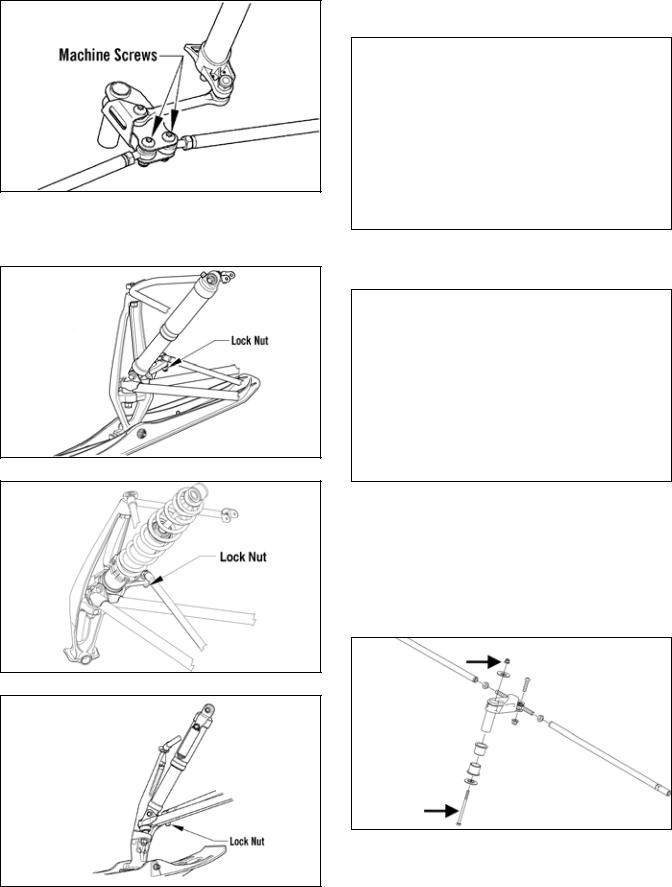
SNO-349
2.Remove the nyloc nuts securing the steering tie rod ends to the spindle arms. Account for the washers and discard both nuts.
SNO-353
ONS-189
ONS-270
3.Slide the steering tie rod out of the steering boot and out of the snowmobile.
4.Remove the screw and lock nut securing the steering tie rod end to the steering arm. Discard the nut.
SNO-350
5.Remove the lock nut securing the steering tie rod to the steering post. Discard the nut.
SNO-351
NOTE: At this point if the technician’s objective is to remove the steering arm, the reinforcement bracket will need to be removed by drilling out the appropriate rivets.
6.Remove all Torx-head screws securing the front skid plate to the chassis; then remove the cap screw and nut securing the steering arm to the chassis. Account for two washers and two bushings.
SNO-829A
INSPECTING
1.Inspect the ball joints for damaged threads or wear.
2.Inspect the tie rod for damage, unusual bends, or wear.
22
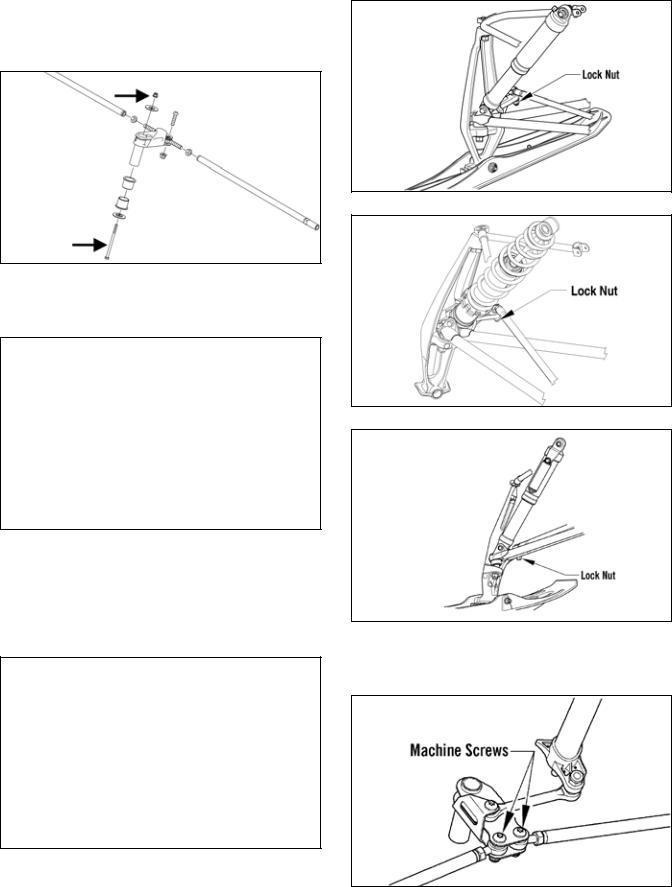
INSTALLING
1.Secure steering arm into position and secure using the existing cap screw and flat washers, and new nut. Tighten to 96 in.-lb (10.8 N-m).
SNO-829A
2.Place the steering tie rod into position on the steering post. Secure with a new nyloc nut. Tighten to 55 ft-lb (74.8 N-m).
SNO-351
NOTE: Make sure the tie rod tab is fully seated into the steering post and threads of the ball joint are above the nut when tightened correctly.
3.Place the tie rod end into position on the steering tie rod bracket. Secure with a new nyloc nut. Tighten to 20 ft-lb (27 N-m).
SNO-350
4.Slide the steering tie rod through the steering boot and into the snowmobile; then place the steering tie rod into the spindle arm with the washer. Secure with a new nyloc nut. Tighten to 32 ft-lb (43.5 N-m).
SNO-353
ONS-189
ONS-270
5.Secure the steering tie rod to the steering tie rod bracket with the screw and new nyloc nut. Tighten to 20 ft-lb (27.2 N-m).
SNO-349
23
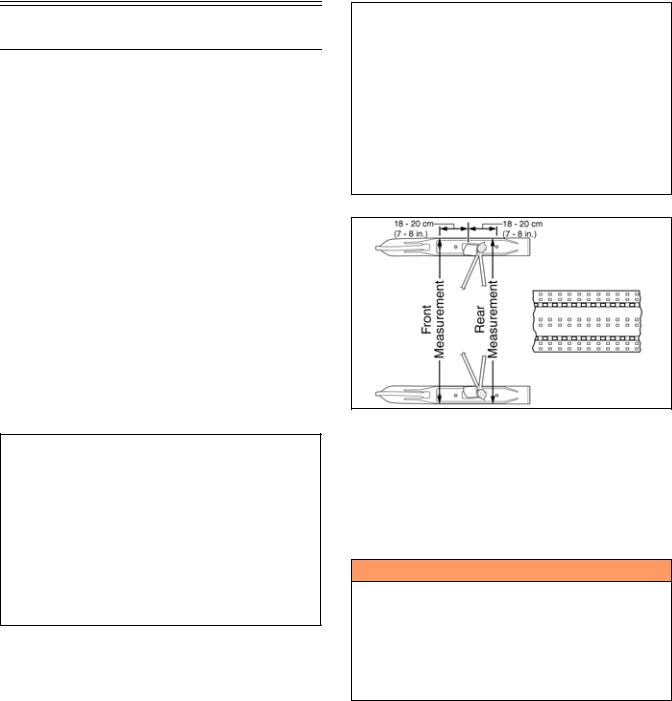
Ski Alignment
CHECKING
NOTE: Track tension and alignment must be properly adjusted prior to checking or adjusting ski alignment. Ski alignment must be performed on a flat, level surface. Ski toe-out must fall within the range of 1/16-1/4 in. (1.6-6.4 mm).
1.Raise the front end of snowmobile just high enough to keep the skis from contacting the floor.
2.Turn the handlebar to the straight-ahead position. Visually inspect the handlebar for being centered and in the straight-ahead position.
3.With the handlebar in the straight-ahead position, secure the handlebar to prevent the alignment from becoming disturbed during the remainder of the alignment procedure.
NOTE: Track tension and alignment must be properly adjusted prior to placing the straightedge against the outside edge of the track.
4.Place a long straightedge against the outside edge of the track so it lies near the inside edge of the left-side ski.
729-887B
NOTE: The straightedge should be long enough to extend from the back of the track to the front of the ski.
5.Measure the distance from the straightedge to the left-side ski wear bar bolts in two places: approximately 7-8 in. (18-20 cm) in front of the spindle and 7-8 in. (18-20 cm) behind the spindle. Record the measurements taken for the left side.
729-887A
0734-408
6.Place the straightedge against the outside edge of the track so it lies near the inside edge of the right-side ski.
7.Measure the distance from the straightedge to the right-side ski wear bar bolts in two places: 7-8 in. (18-20 cm) in front of the spindle and 7-8 in. (18-20 cm) behind the spindle. Record the measurements taken for the right side.
! WARNING
The measurement from the front and rear wear bar bolts to the straightedge can be equal (ski parallel to the track), but the front measurement must never be less (ski toed-in) or poor handling will be experienced. The front wear bar bolt measurement to the straightedge must not exceed the measurement from the rear wear bar bolt to the straightedge (ski toed-out) by more than 5/32 in. (4 mm).
8.If ski alignment is not as specified, adjust the alignment of the ski(s) not parallel to the straightedge.
ADJUSTING
NOTE: The following procedure can be used to adjust the alignment of either ski.
NOTE: The rivets securing the steering boots will have to be removed in order to adjust the inner tie rod ends.
1.Secure the steering tie rod in the centered position.
2.Loosen both spindle tie rod jam nuts on the same side as the ski to be aligned.
24
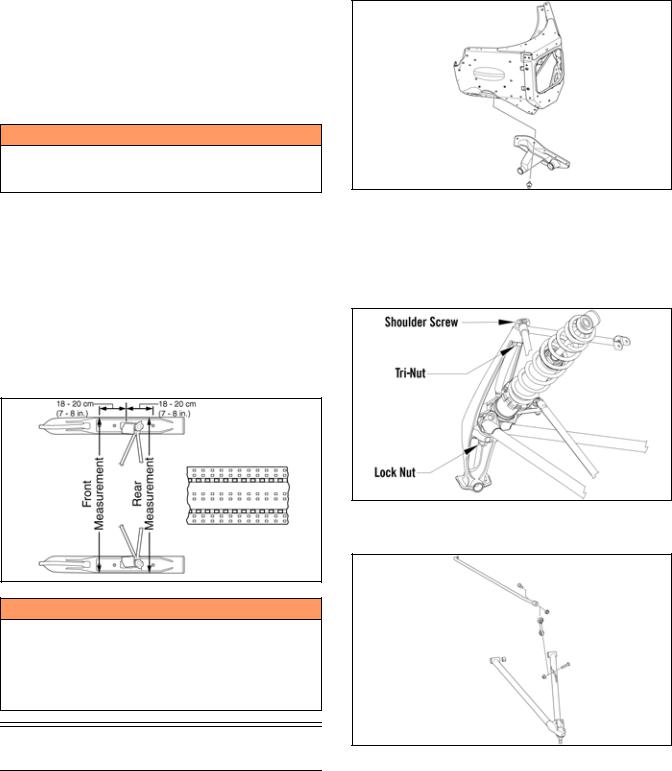
3.Using a wrench on the spindle tie rod “flats,” rotate the spindle tie rod until recommended specification is attained.
4.Apply blue Loctite #243 to each jam nut thread area; then tighten the jam nuts against the spindle tie rod.
NOTE: Repeat this procedure on each side (if necessary) until ski toe-out is within specification.
! WARNING
Neglecting to lock the tie rod by tightening the jam nuts may cause loss of snowmobile control and possible personal injury.
VERIFYING
1.With the handlebar in the straight-ahead position, verify ski alignment by measuring across from the outside edge of the left-side wear bar bolts to the outside edge of the right-side wear bar bolts (without using the straightedge) in two places: approximately 7-8 in. (18-20 cm) in front of the spindle and 7-8 in. (18-20 cm) behind the spindle.
2.The measurement from in front of the spindle to the outer edge of the wear bar bolts (without using the straightedge) must not exceed the rear measurement by more than 1/16-1/4 in. (1.6-6.4 mm) toe-out.
0734-408
! WARNING
The measurement taken in front of the spindle must never be less than the measurement taken behind the spindle or poor handling will be experienced. Neglecting to lock the tie rod by tightening the jam nuts may cause loss of snowmobile control and possible personal injury.
A-Arms (ZR/Riot)
REMOVING
1.Elevate the front of the snowmobile and secure using a suitable support stand.
2.Remove the Torx-head screws securing the front skid plate to the chassis; then remove the front skid plate.
3.Remove the eight push rivets securing the steering boot to the chassis; then slide the boot away from the chassis.
SNO-763
4.Remove the ski shock.
5.Remove the shoulder screw and tri-nut securing the upper A-arm, and the lower lock nut securing the lower A-arm. Using a rubber mallet, remove the lower arm from the spindle. Discard the lower lock nut.
ONS-190
6.Remove the cap screw and lock nut securing the sway bar link to the lower arm.
SNO-764
7.Remove the two cap screws and nyloc nuts securing the lower arm to the chassis; then slide the boot from the arm and remove the arm.
8.Remove the two cap screws and lock nuts securing the upper arm to the chassis.
INSPECTING
1.Inspect the arm welded areas for cracks or any signs of deterioration.
2.Inspect the bearings and axles for wear or damage.
25
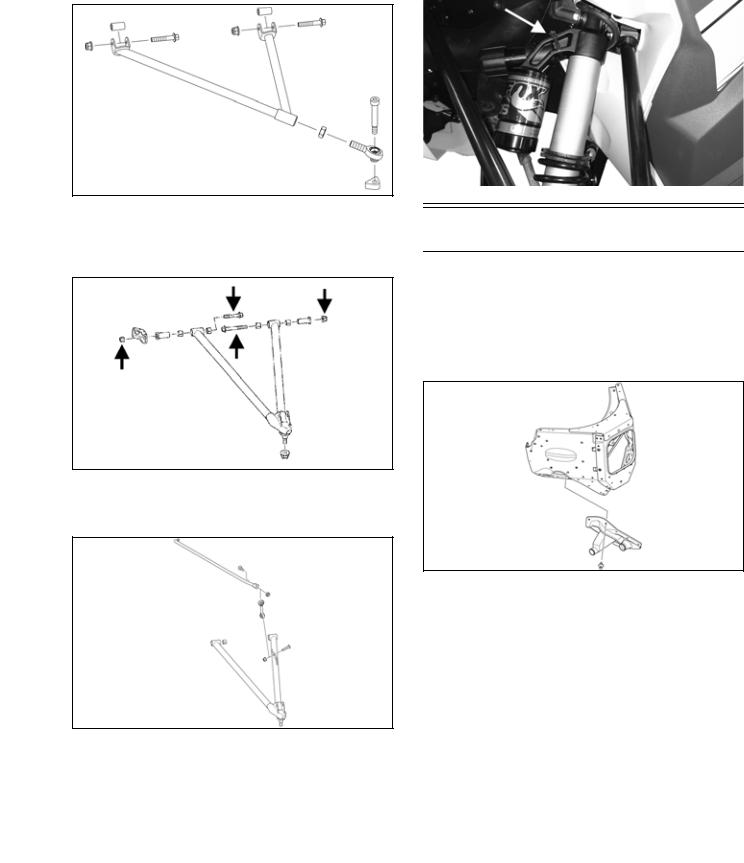
3.Inspect the arm tubing for signs of twisting or bending.
4.Inspect mounting location of the chassis for cracks or wear.
INSTALLING
1.Place the upper arm into position on the chassis and secure with the cap screws and new nyloc nuts. Tighten to 108 in.-lb (12.2 N-m).
5.Install the ski shock absorber. Tighten to 32 ft-lb (43.5 N-m).
6.Place the front skid plate into position; then secure with the Torx-head screws.
NOTE: On models with FOX iQS shocks, once the shocks are installed, route the wires around the shock and connect to the shock making sure they click into place. Cable tie the wires to the shock body.
SNO-572
2.Slide the lower arm into the boot; then place the arm into position on the chassis. Secure with the cap screws and new nyloc nuts and tighten to 65 ft-lb (88.4 N-m) (front) and 45 ft-lb (61.2 N-m) (rear).
SNO226A
3.Secure the sway bar link to the lower arm with the cap screw and new nyloc nut. Tighten to 23 ft-lb (31.3 N-m)
SNO-764
4.Secure the A-arms to the spindle using one new lock nut and one new tri-nut. Tighten the lock nut to 45 ft-lb (61.2 N-m) and the shoulder screw to 20 ft-lb (27.2 N-m).
YM-218
A-Arms (Norseman X)
REMOVING
1.Elevate the front of the snowmobile and secure using a suitable support stand.
2.Remove the push rivets securing the steering boot to the chassis; then slide the boot away from the snowmobile.
SNO-763
3.Remove the Torx-head screws securing the front skid plate to the chassis; then remove the front skid plate.
4.Remove the ski shock absorber.
5.Remove the two lock nuts securing the spindle to the A-arms; then using a rubber mallet, remove the arms from the spindle. Discard the nuts.
26
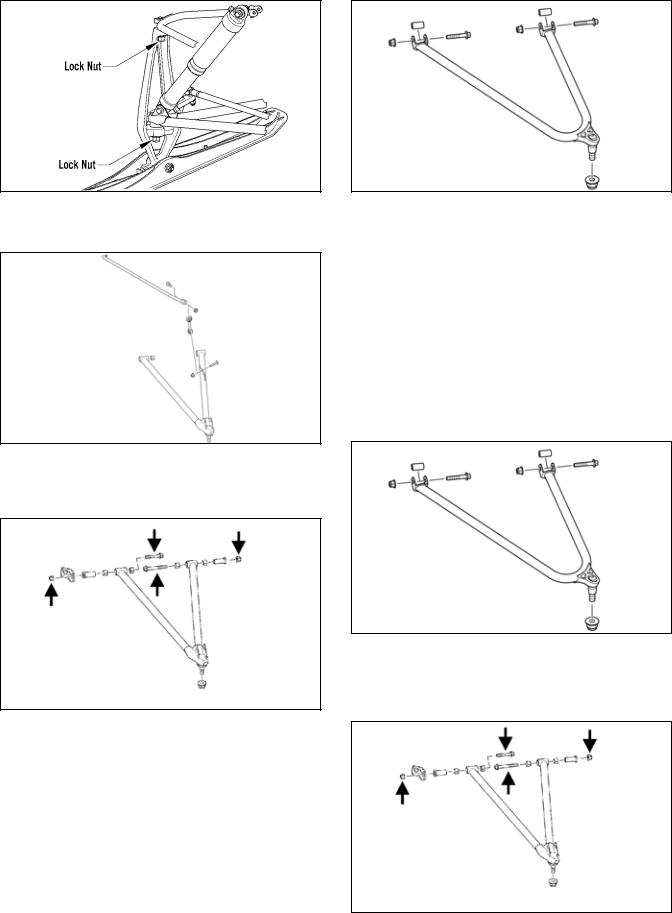
SNO-354
6.Remove the cap screw and lock nut securing the sway bar link to the lower arm. Discard the nut.
SNO-764
7.Remove the two cap screws and nyloc nuts securing the lower arm to the chassis; then slide the boot from the arm and remove the arm.
SNO-226A
8.Remove the two cap screws and lock nuts securing the upper arm to the chassis. Discard the nuts.
SNO-571
INSPECTING
1.Inspect the arm welded areas for cracks or any signs of deterioration.
2.Inspect the bearings and axles for wear or damage.
3.Inspect the arm tubing for signs of twisting or bending.
4.Inspect mounting location of the chassis for cracks or wear.
INSTALLING
1.Place the upper arm into position on the chassis and secure with the cap screws, axles, and new nyloc nuts. Tighten to 23 ft-lb (31.3 N-m).
SNO-571
2.Slide the lower arm into the boot; then place the arm into position on the chassis. Secure with the cap screws and new nyloc nuts and tighten to 65 ft-lb (88.4 N-m) (front) and 45 ft-lb (61.2 N-m) (rear).
SNO-226A
27
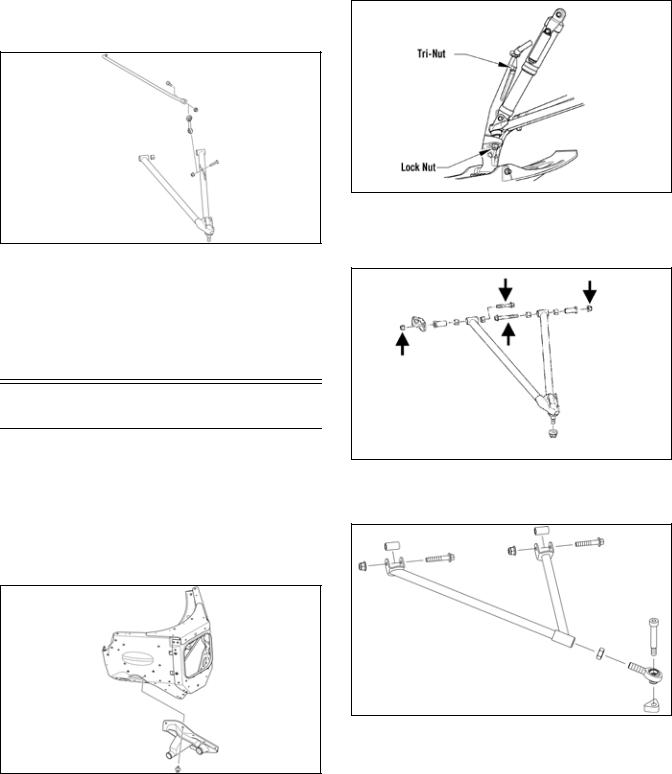
3.Secure the sway bar link to the lower arm with the cap screw and new nyloc nut. Tighten to 23 ft-lb (31.3 N-m).
SNO-764
4.Secure the A-arms to the spindle using two new nyloc nuts. Tighten to 45 ft-lb (61.2 N-m).
5.Install the ski shock absorber. Tighten to 32 ft-lb (43.5 N-m).
6.Place the front skid plate into position; then secure with the Torx-head screws.
A-Arms (Riot X/Alpha One)
NOTE: Always use new lock nuts when replacing any steering components.
REMOVING
1.Elevate the front of the snowmobile and secure using a suitable support stand.
2.Remove the push rivets securing the steering boot to the chassis; then slide the boot away from the snowmobile.
SNO-763
3.Remove the Torx-head screws securing the front skid plate to the chassis; then remove the front skid plate.
4.Remove the ski shock absorber.
5.Remove the lock nut, machine screw, and tri-nut securing the spindle to the A-arms; then using a rubber mallet, remove the lower A-arm from the spindle.
0749-480A
6.Remove the two cap screws and nyloc nuts securing the lower arm to the chassis; then slide the boot from the arm and remove the arm.
SNO-226A
7.Remove the two cap screws and lock nuts securing the upper arm to the chassis.
SNO-572
INSPECTING
1.Inspect the arm welded areas for cracks or any signs of deterioration.
2.Inspect the bearings and axles for wear or damage.
3.Inspect the arm tubing for signs of twisting or bending.
4.Inspect mounting location of the chassis for cracks or wear.
28
